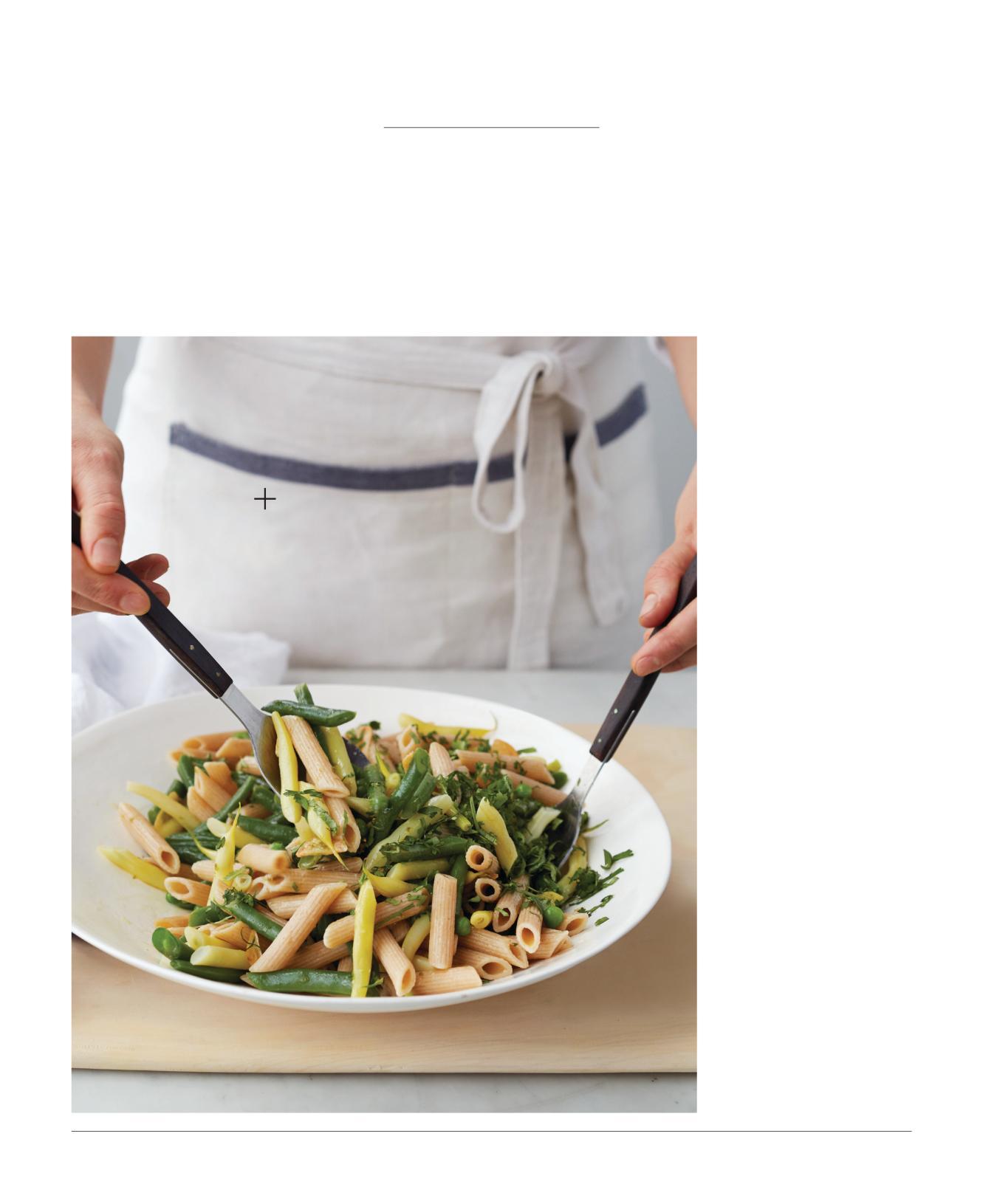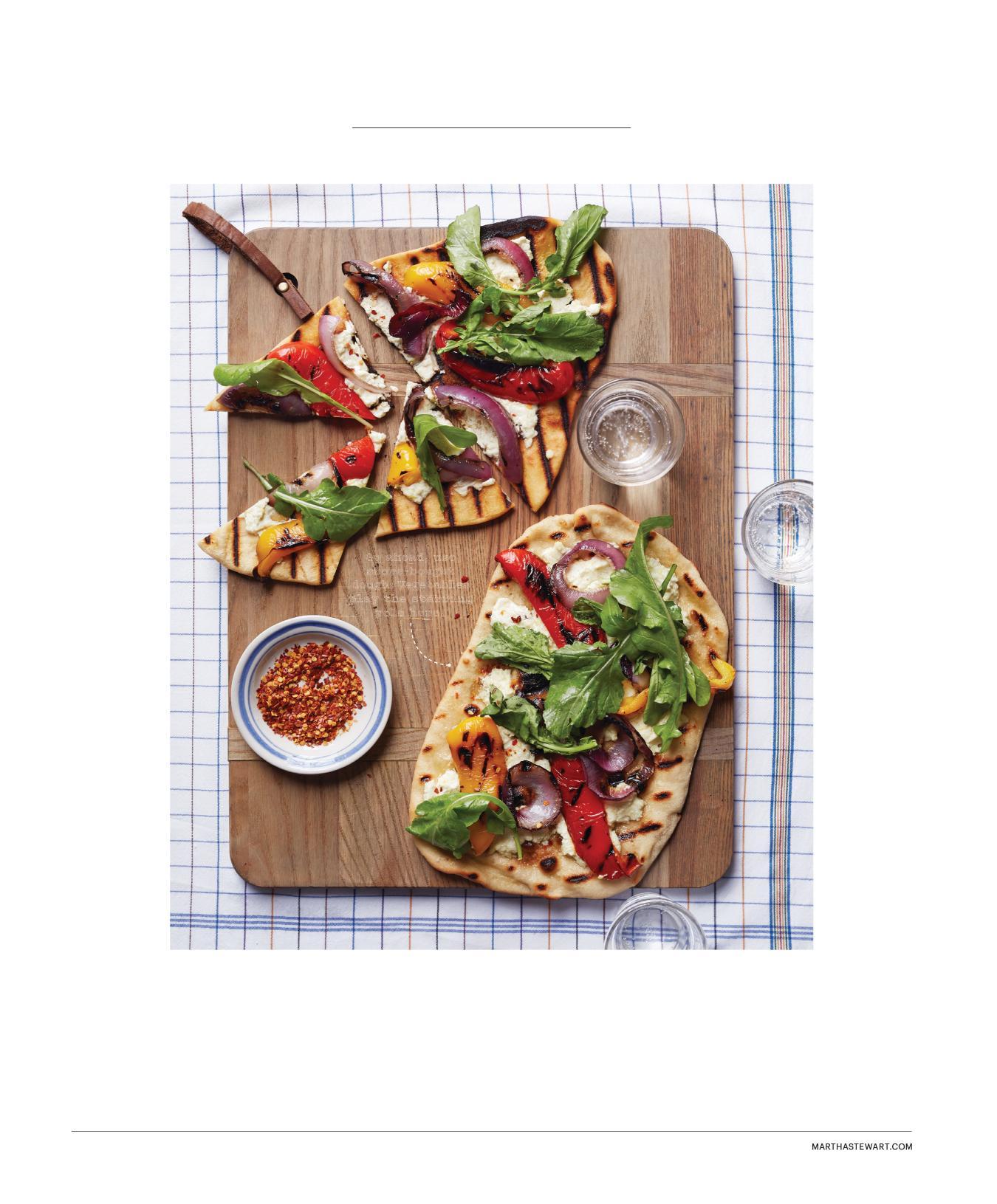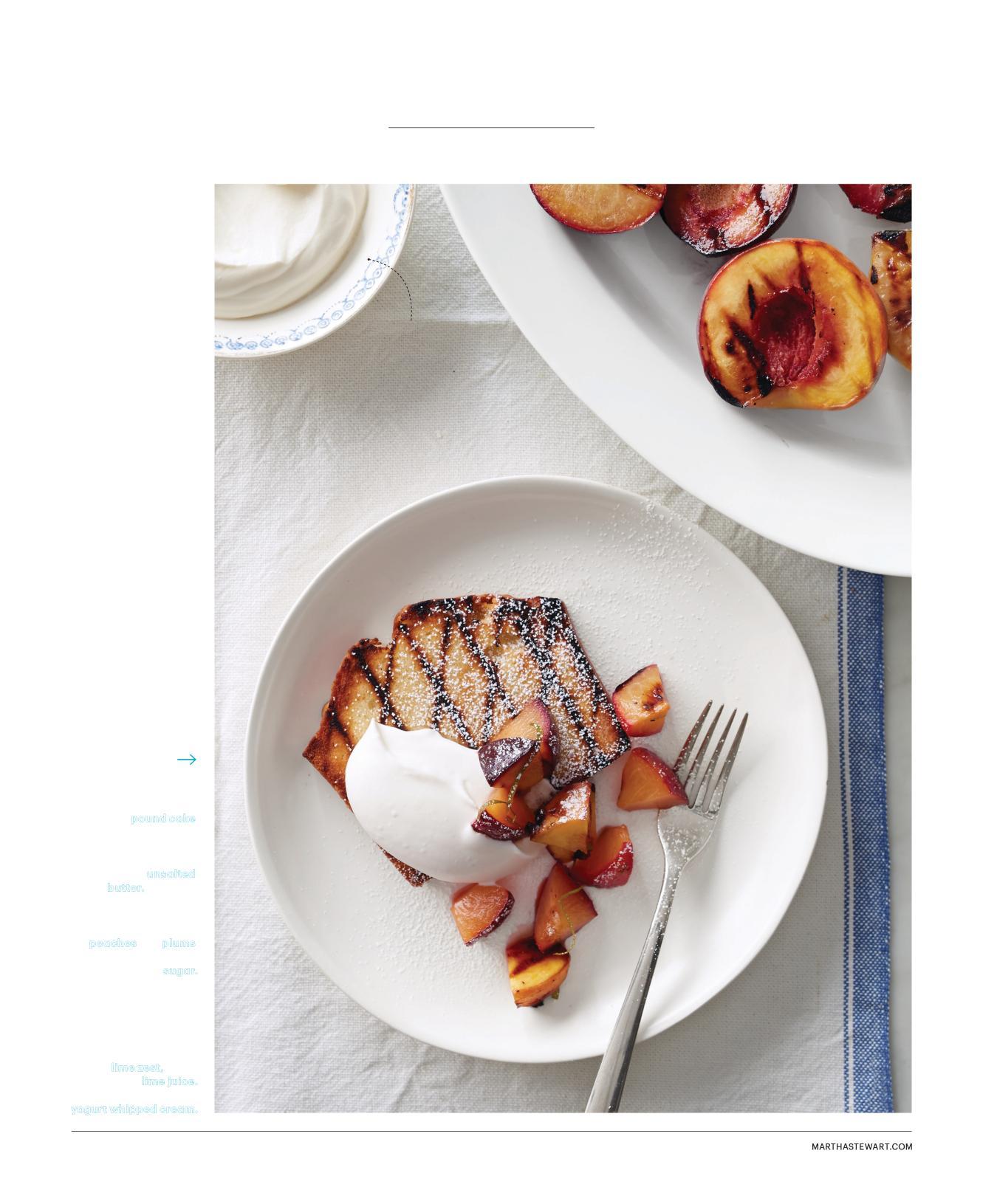
26 minute read
Ask Martha
FOOD & GATHERINGS
Q:
Advertisement
I love the idea of a grilled dessert. Is there a recipe you’d recommend?
—Roz Pactor, Houston A: There are lots of sweet finales that benefit from a bit of fire. A few minutes over the coals gives fruit a caramelized flavor. Consider these flame-kissed plums and peaches atop grillmarked pound cake.
PHOTOGRAPHS BY BRYAN GARDNER
For a rich, slightly tangy topping, whisk together two parts whipped cream and one part Greek yogurt; add sugar to taste.
Grate Expectations
Brush half-inch-thick slices of pound cake (for our recipe, go to marthastewart.com/ classic-pound-cake) with melted unsalted butter. Grill over medium heat, turning once, until toasted. Brush halved and pitted peaches and plums with more melted butter; sprinkle with sugar. Grill, cut-sides down, until golden, 2 to 3 minutes; flip and cook 1 to 2 minutes more. Remove and dice, then sprinkle with more sugar, lime zest, and a squeeze of lime juice. Serve cake with fruit and yogurt whipped cream.
Ask Martha
FOOD & GATHERINGS
Q: What’s the secret to evenly grilled meat?
—Bob White, Summit, N.J. A: Temperature control—and a good thermometer. On a gas grill, setting an area to a specific intensity will produce the same heat each time. A charcoal grill is less consistent: Check your grill’s built-in gauge, or place an oven thermometer on a rack above the grates in an indirect heat zone. For indirect heat in a gas grill, preheat over high, then reduce one area to mediumlow or off; in a charcoal grill, leave one side free of coals. Begin cooking larger cuts over direct heat; move to indirect if the outside is charring before the meat is cooked through.
MEDIUMRARE
MEDIUM
WELLDONE MEAT TEMPERATURES 101
BEEF GROUND BEEF PORK GROUND PORK POULTRY
1300
1400 1600 1400 1600 1650
1600 1600
To tell when meat has hit the right temperature, stick a thermometer into the thickest part of the fl esh, avoiding bones. Match the reading to our guidelines* , then let rest (off heat) 10 minutes.
*For some cuts, the USDA recommends higher temperatures, especially when you’re cooking for pregnant women or those with weakened immune systems. For details, go to usda.gov.
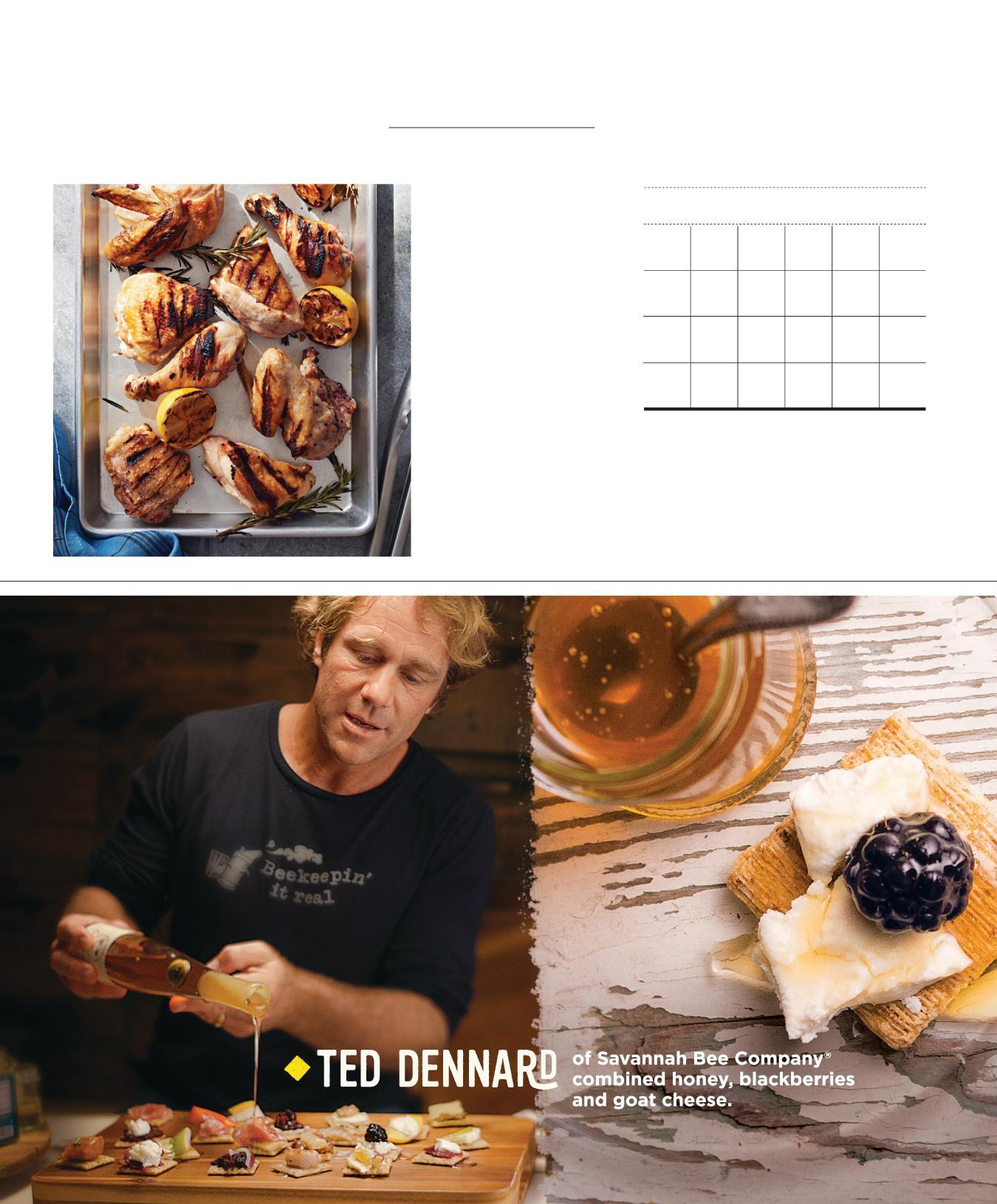
Q: What’s the best way to set up an outdoor buffet?
—Jordan Parker, Columbia, Mo. A: Thoughtful placement will keep the food fresh and your guests well-fed. Set the table close to the house, but not so near that people can’t easily move around it. Have everyone start at one end, letting them serve themselves from both sides. Position platters where they can be refilled easily: grilled foods close to the grill, and cold salads near the door to the house. A separate drink station avoids spills on the buffet.
Ask Martha
FOOD & GATHERINGS
Rest cold salads on ice. Put condiments on both sides of the buffet.
Lay napkinwrapped silverware at the end.
Stack plates at the head of the table. Set out tongs so guests can snap up food with one hand.

JUNE
PHOTOGRAPH BY MIKKEL VANG
Summer Starts Here

WINNER
Coconuts, jackfruits, and mangoes overflow at the Pine Island Tropical Fruit Market. In the summer, customers from all over the world come to sample up to 30 diff erent kinds of mangoes at a time, says Steve Cucura, co-owner of FruitScapes, the nursery connected to the market. “It’s a cultural destination.”
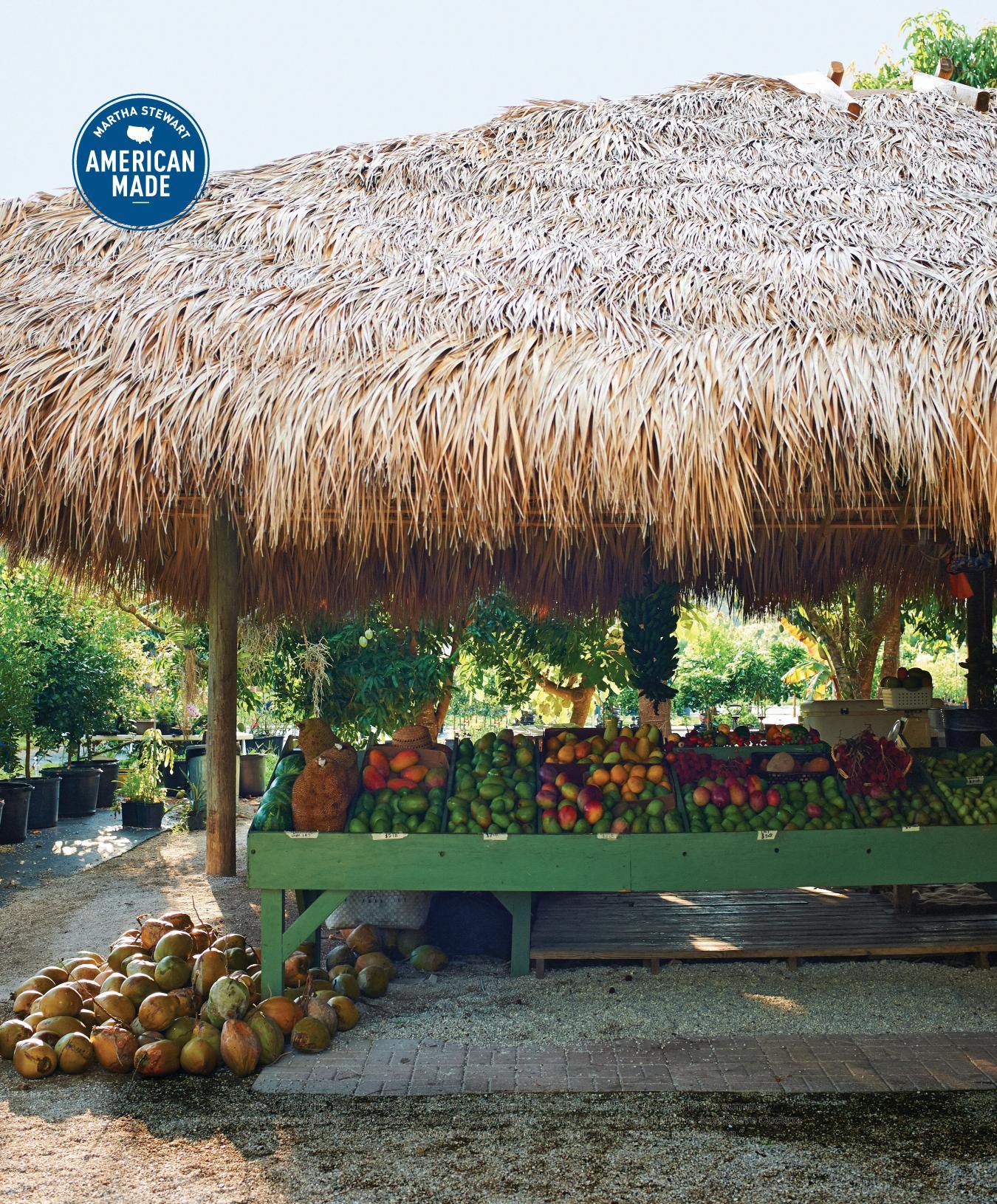
TAMARINDS
JACKFRUITS LYCHEES
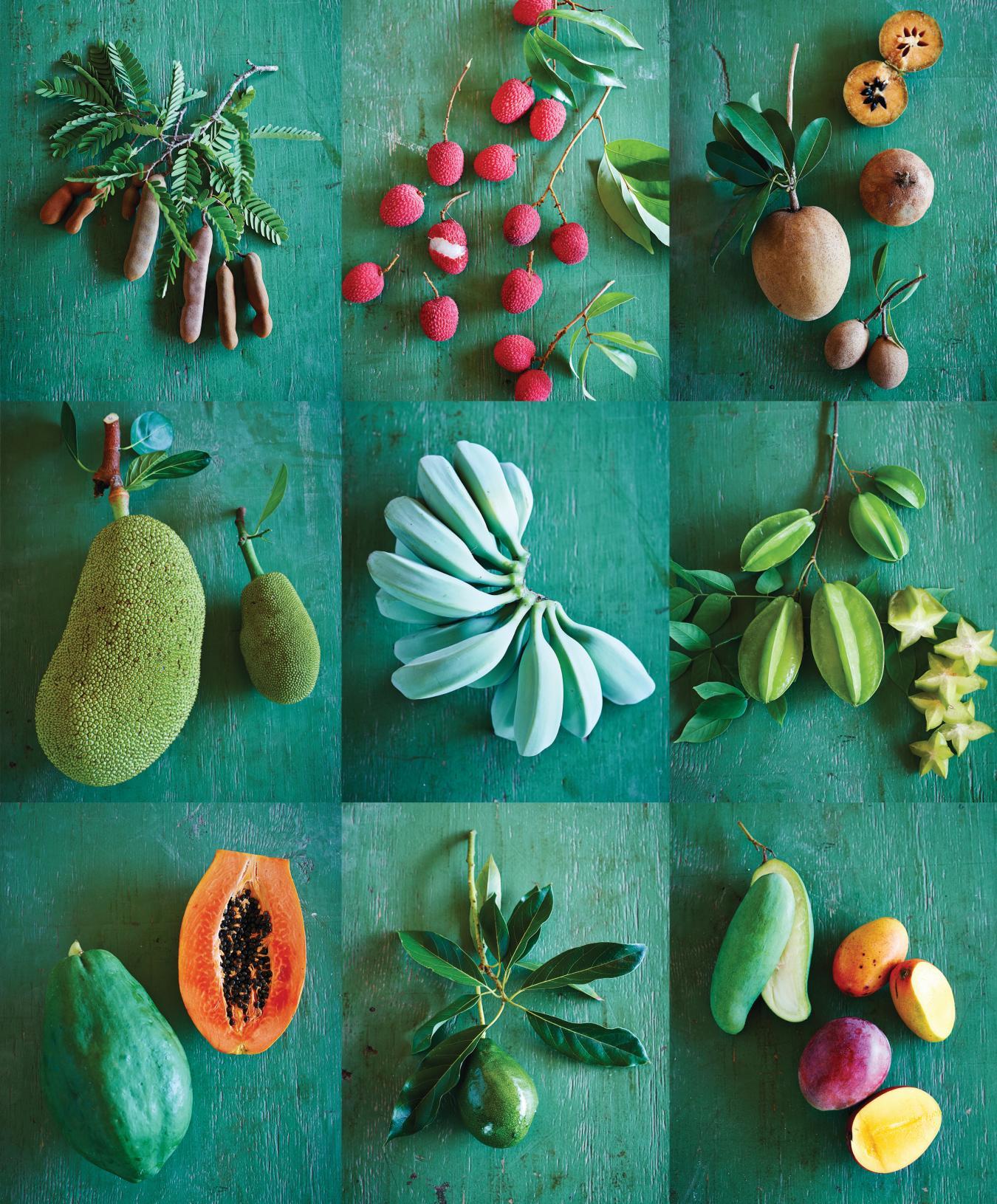
TROPIC WONDERS
BLUE JAVA BANANAS SAPODILLAS
STAR FRUITS (CARAMBOLAS)
At a bustling roadside market on Pine Island, Florida, four impassioned farmers share a mission: to produce a vast selection of exotic fruits, plants, and homemade goods for a hungry, happy public. Along the way, they’ve created a warm community hub and captured our attention as pioneers who embody our American Made spirit.
PAPAYA
AVOCADO MANGOES
THE SELF-TAUGHT BOTANIST
Gary Schneider grows more than 30 varieties of sugarcane at his nursery. “We use it for juice,” he says.
THE BAKER AND MAKER

Avocado-coconut bread and mango jam and chutney are a few of Donna Schneider’s best-selling products at the market. THE INTREPID FARMER
“It’s a little paradise where you can grow so many things,” says Steve Cucura of Pine Island, where he moved in 1999 to farm mangoes.
THE PROPAGATOR
“I never stop learning,” says Jesse Avalos, who is FruitScapes’ resident expert at breeding new plants.
Grafting, the act of joining two plants at the stem so both can flourish, is a skill that even the most gifted gardener takes years to master. It’s also an apt term for a tropical-fruit business that is thriving on Pine Island, Florida, a 17-mile stretch of sandy soil, coral rock, and mangroves located off the southwestern coast of the state. There, in the cool shade of a grass-roofed stand, two pairs of growers—Steve Cucura and Jesse Avalos, and Gary and Donna Schneider—converge every weekend at the Pine Island Tropical Fruit Market to sell just-picked produce, plants, and homemade treats from their respective farms.
Steve and Jesse are the co-owners of FruitScapes Nursery (fruitscapesllc .com), a 10-acre fruit-tree grove where the market, open seven days a week, stands. Husband and wife Gary and Donna own Pine Island Tropicals (pineislandtropicals.com), a 16-acre wholesale business specializing in ornamental plants and organic produce. Together, they offer a dizzying selection of fruits, some familiar (mangoes, lychees), others less so (black sapotes, sapodillas). Donna also sells breads, jams, and sauces she makes from surplus produce, and the stand presses sugarcane juice on the spot for thirsty customers. “We have a nice ecosystem going,” Gary says.
When the two nurseries joined forces eight years ago, it was a marriage of the established and the new. Florida natives Donna and Gary opened for business in 1993, with a focus on hibiscuses and orchids. On the side, Gary, a bit of a mad scientist in the garden, began collaborating with a friend at the USDA’s Subtropical Horticulture Research Station in Miami to test whether certain fruits from around the world would grow in Pine Island’s very specific climate. Steve, a Virginia native, was working as an accountant in Gainesville when he first visited the island in 1999, and he quit his desk job a few weeks later to apprentice at two farms. “I was 28,” he says. “I was healthy and energetic, and I didn’t care about money.” In 2008, he and fellow apprentice Jesse Avalos, a California transplant and a meticulous student of grafting, bought the property that is now FruitScapes. After the economic crisis that year, Steve and Jesse, who consider Gary both a mentor and a friend, saw an opportunity that would benefit both businesses. “We invited them to come sell with us, and in return they helped with sales on weekends,” Steve says. “We created a community market.” Within six months, Donna’s goods had also become so popular, she was able to quit her waitressing day job.
Now, on any given Friday or Saturday (the days Donna and Gary work) the market is a madhouse. In addition to the many locals, a large percentage of customers are immigrants from Asia, the Caribbean, and Central and South America seeking childhood flavors, says Steve. And that’s precisely what motivates the foursome, he adds: “We look for fruits that are almost extinct, uncommon, ugly, bizarre, or popular in an isolated area of the globe, and bring them back to see if we can keep them going.”
THE GOLDEN HOUR
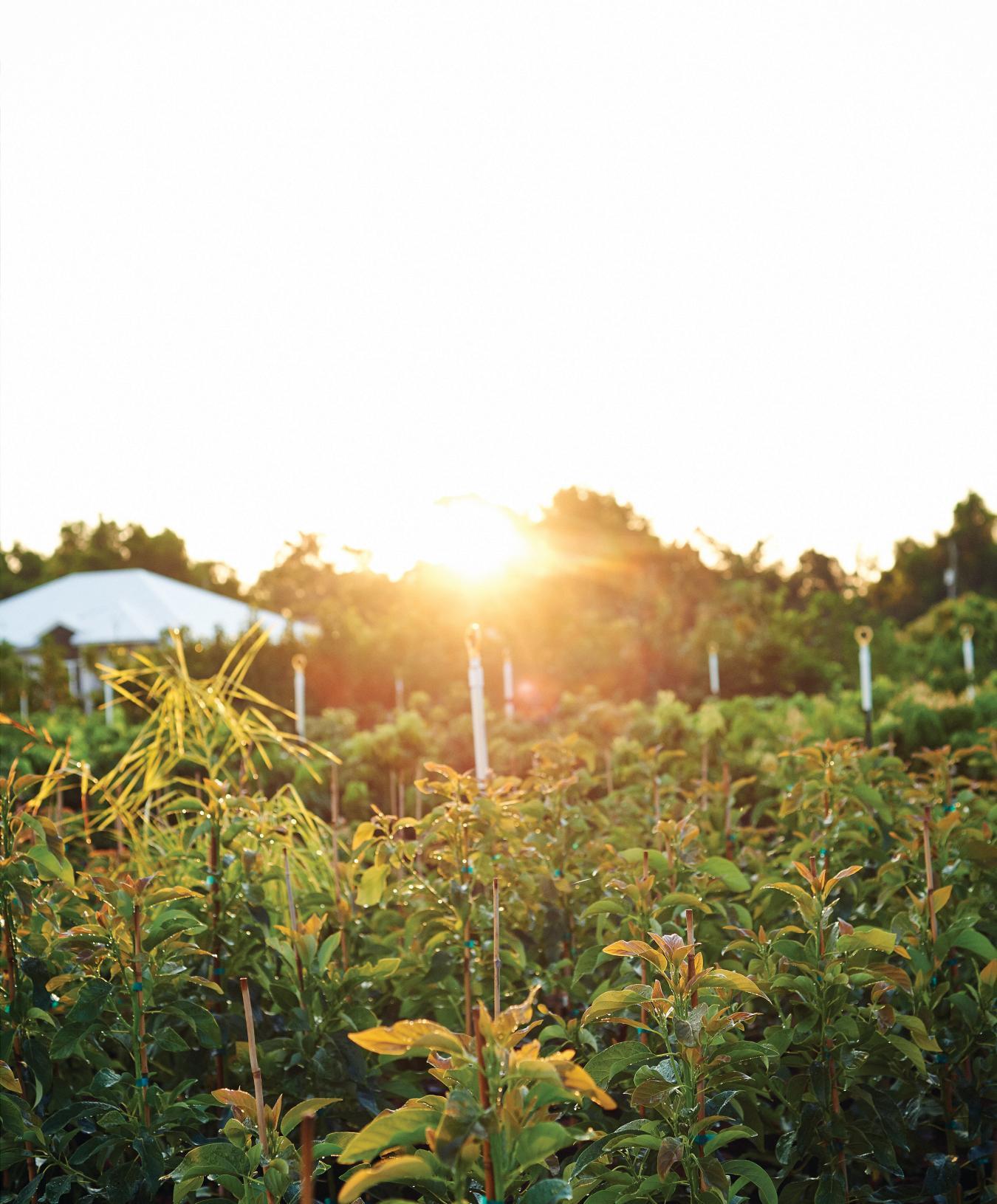
The sun sets on a grove of young avocado trees at FruitScapes Nursery. Other popular plants there include about 100 mango varieties, 12 citrus-fruit trees, and six kinds of lychees. Owners Steve and Jesse introduce two or three new varietals every year. To learn more about the Martha Stewart American Made program, visit americanmade.marthastewart.com.
RIPE FOR THE PICKING
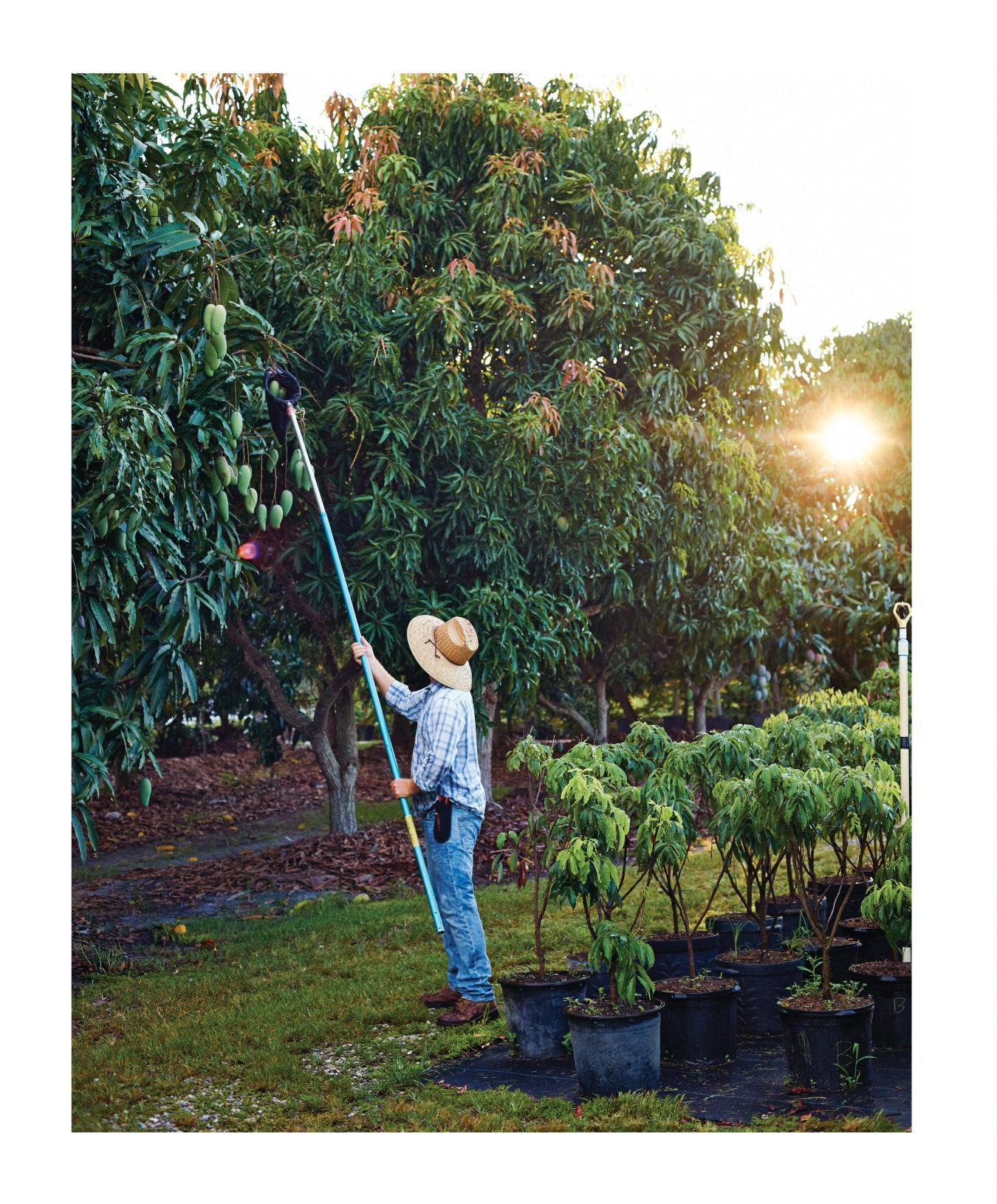
Thanks to the market, customers at FruitScapes can taste a specific fruit before buying the tree it grows on. “That’s missing from most nurseries,” says Steve, shown here harvesting mangoes. “We wanted to off er a well-rounded experience.”
TROPICAL FRUIT WITH COCONUTPISTACHIO CRUNCH
BEACH VACATION IN A BOWL
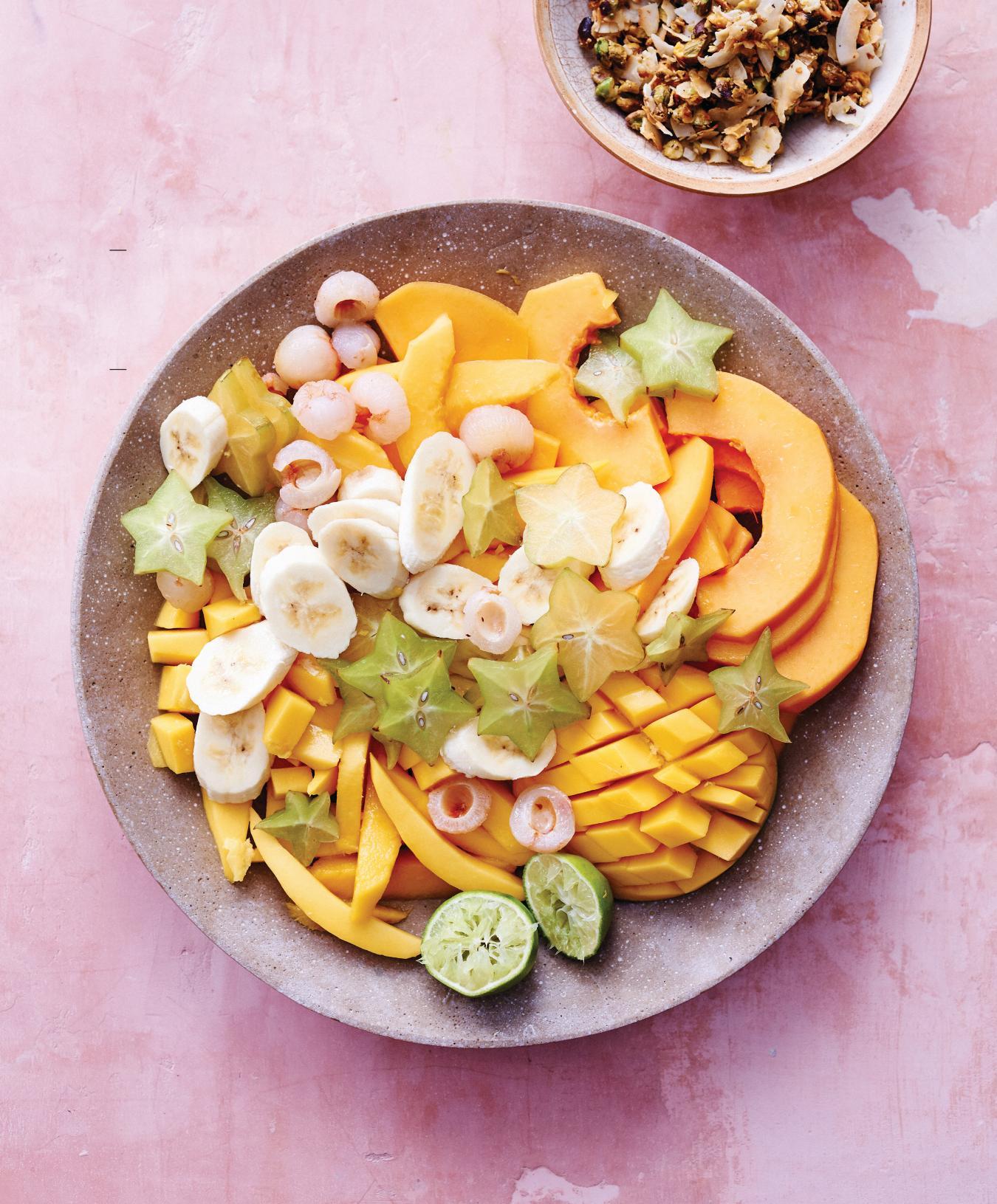
With a breakfast like this, it’s easy to pretend you’re at an exotic retreat (hello, Bali). The mangoes, star fruits (carambolas), bananas, lychees, and papaya are amazing on their own, but a crunchy blend of toasted pistachios, coconut, and cayenne pepper adds a nice kick. Serve it with a spoonful of sour cream or plain yogurt. For recipes, see page 108.
SUN-DRENCHED SMOOTHIES
The ground cinnamon and cardamom in these refreshing mango and papaya lassis bring out the fruit flavors.
At the market, Gary and Donna press raw sugarcane into juice and spike it with ginger and citrus fruits. Gary slices into a Florigon mango. “You can tell when most varieties are ripe because they’re slightly soft and smell fragrant,” he says.
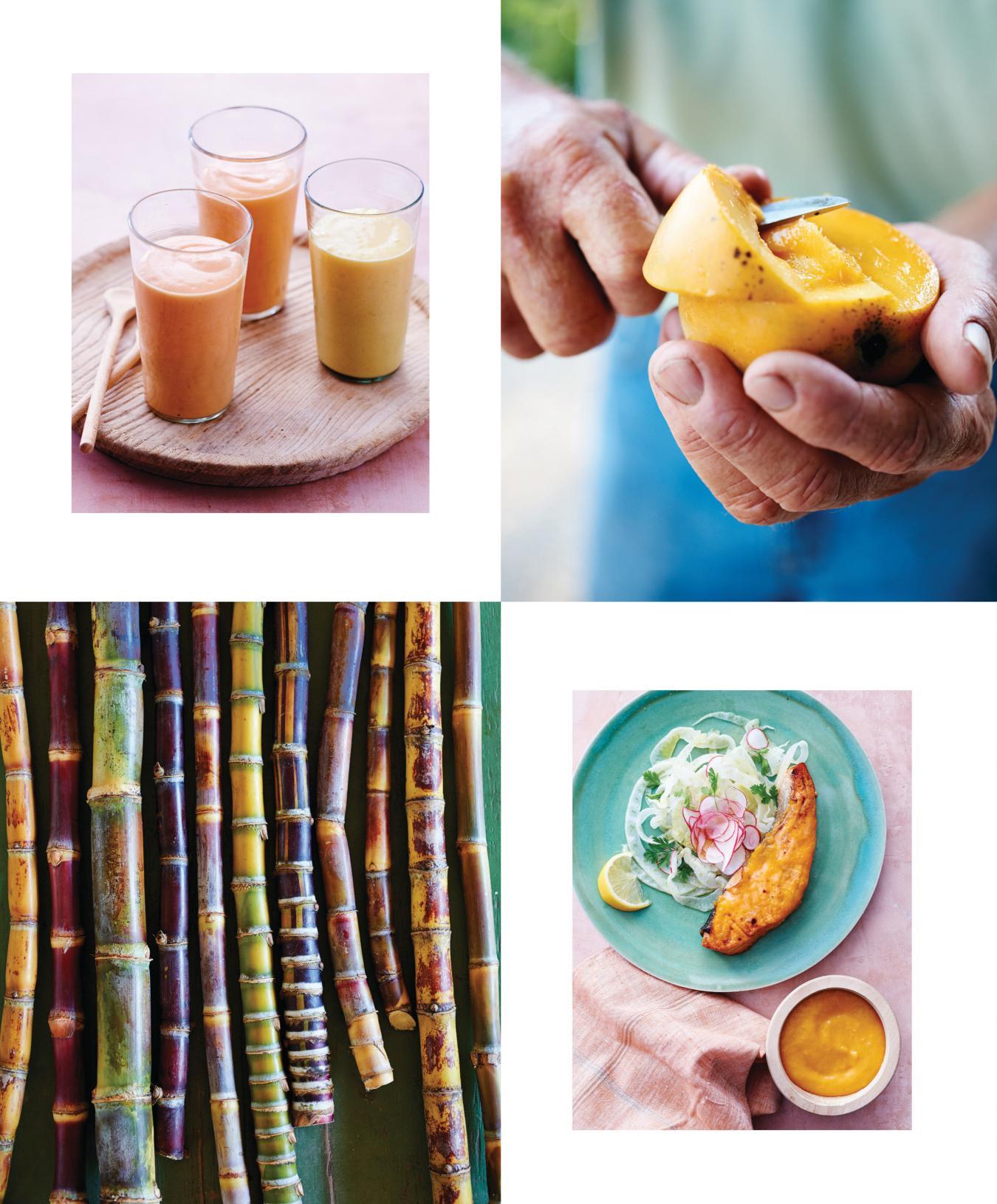
FRUITFUL FISH
In this salmon with a spicy mango barbecue sauce, a chile and the fruit’s acidity cut the richness of the fish, as does a cool fennel-and-radish salad.
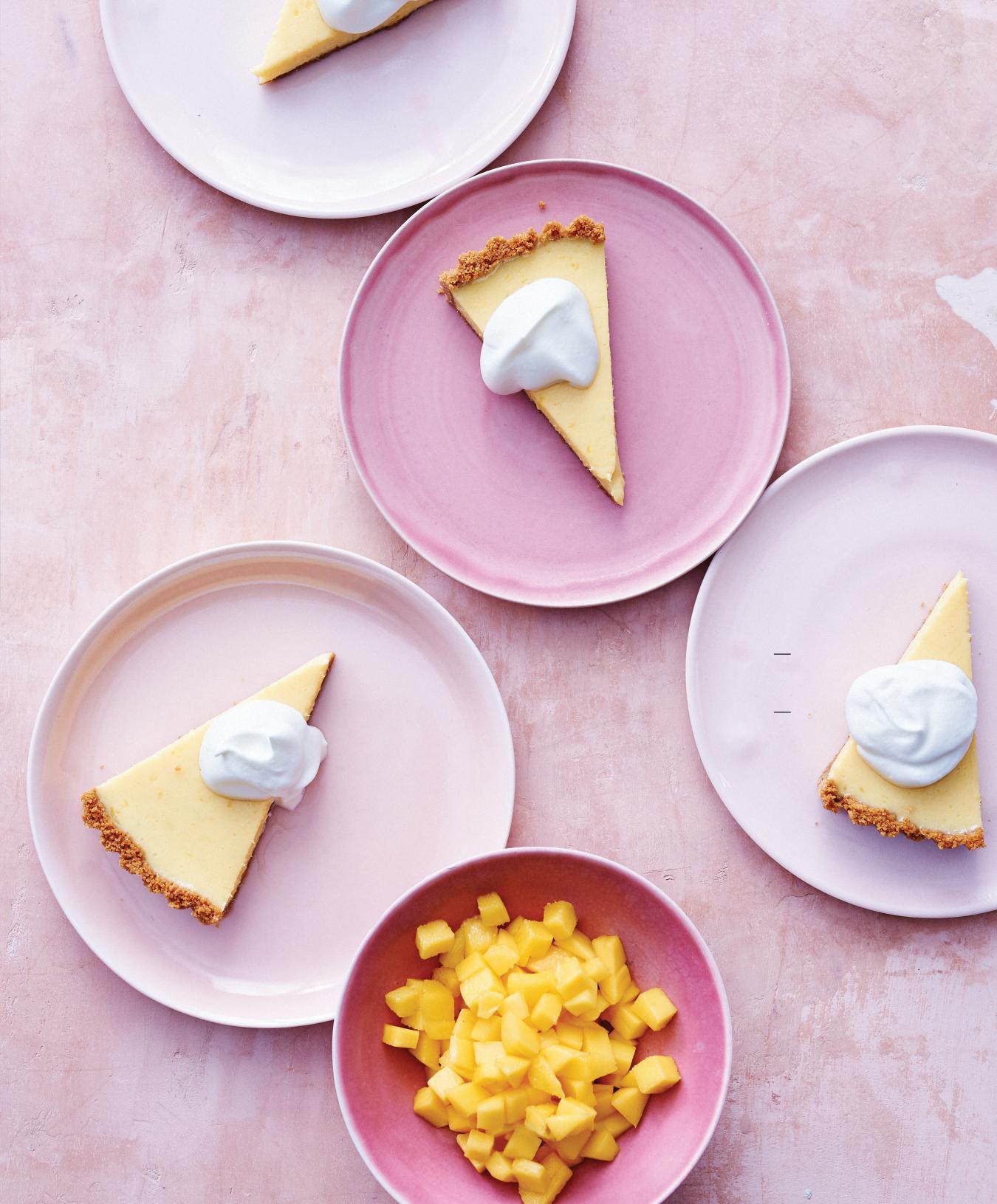
MANGO–KEY LIME TART
SWEET SYNERGY
Be sure to use only ripe and flavorful mangoes in this recipe; otherwise, the tartness of the limes and the sweetness of the condensed milk will be overpowering. Get the balance right, however, and the two tropical fruits meld into a yin and yang of yumminess.
rosemary branch bamboo
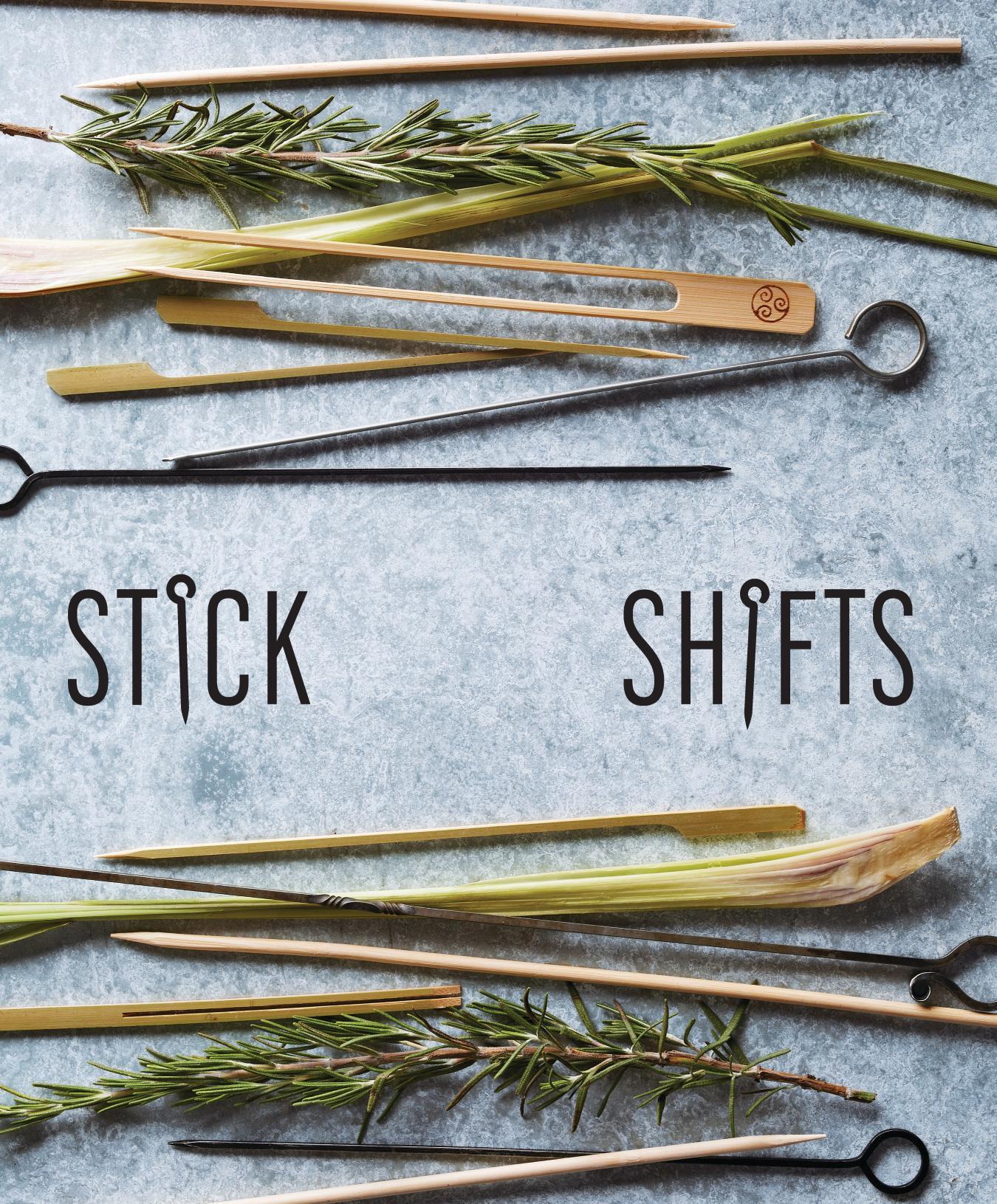
Skewering food and searing it over an open flame has an elemental appeal. It is, after all, the oldest cooking method around, and every culture has its own definition of a kebab — from Greek souvlaki to Puerto Rican churrasco. On the following pages, we put our own spins on five classic combos. Just add clear skies and a chilled glass of vino and you’re good to go.
PHOTOGRAPHS BY BRYAN GARDNER TEXT BY JANE LEAR
metal
lemongrass
Swordfish, Potato, and Onion Skewers With Golden-Raisin Agrodolce
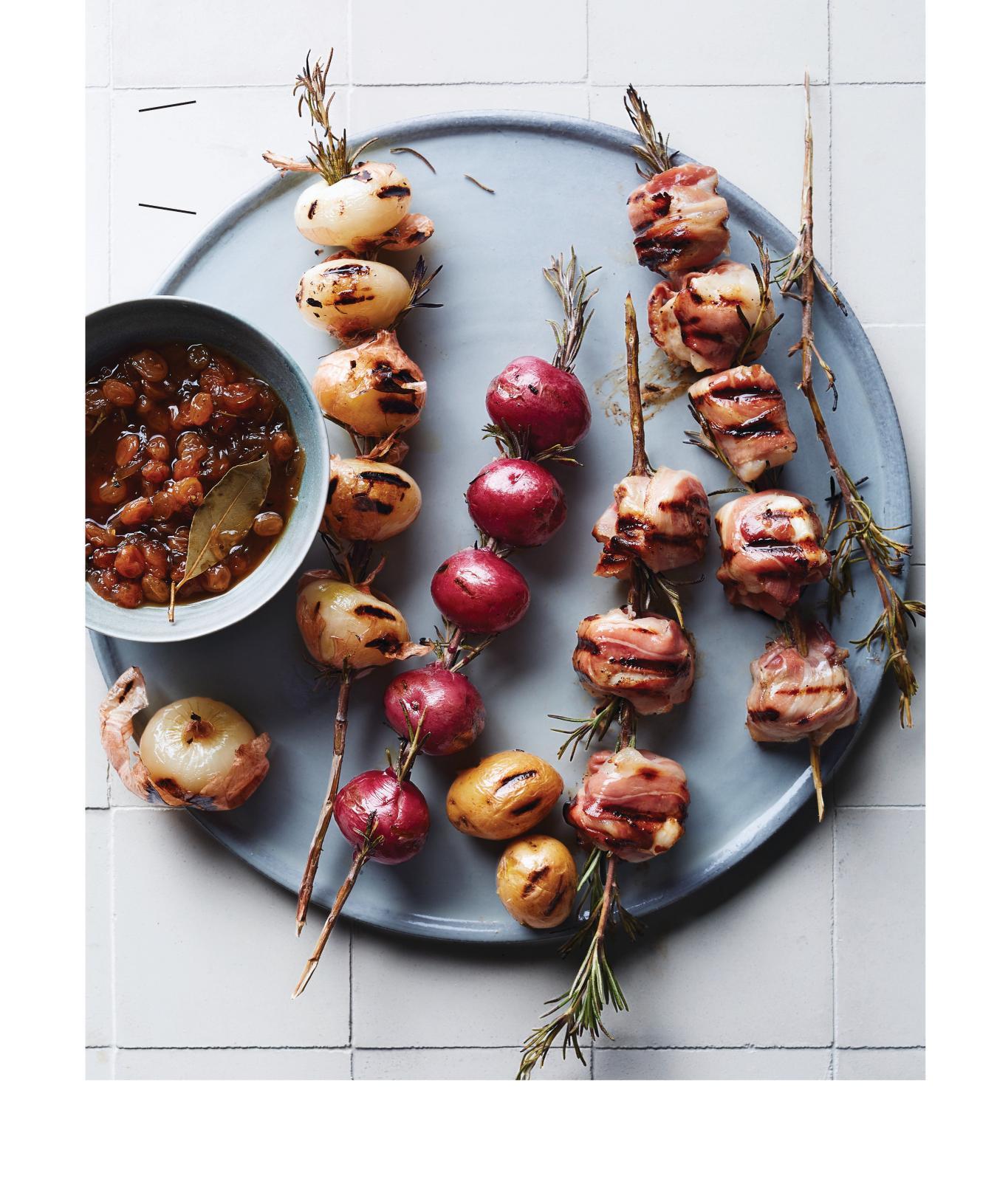
BARBECUE, ITALIAN STYLE
The meat skewers called spiedini are the inspiration here: A pancetta wrapping protects chunks of fresh swordfish that are threaded onto rosemary branches, along with baby potatoes and juicy cipollini onions. A traditional sweet-sour agrodolce adds a tangy finish. Do most of the work on this dish ahead of time, and then take in the sunset while it cooks.
herbal essence
If you have a rosemary plant, snip off the lower sturdy branches. If you don’t have one on hand, use wooden skewers and put a handful of storebought sprigs directly on the fire.
YogurtMarinated Lamb and Chicken Skewers
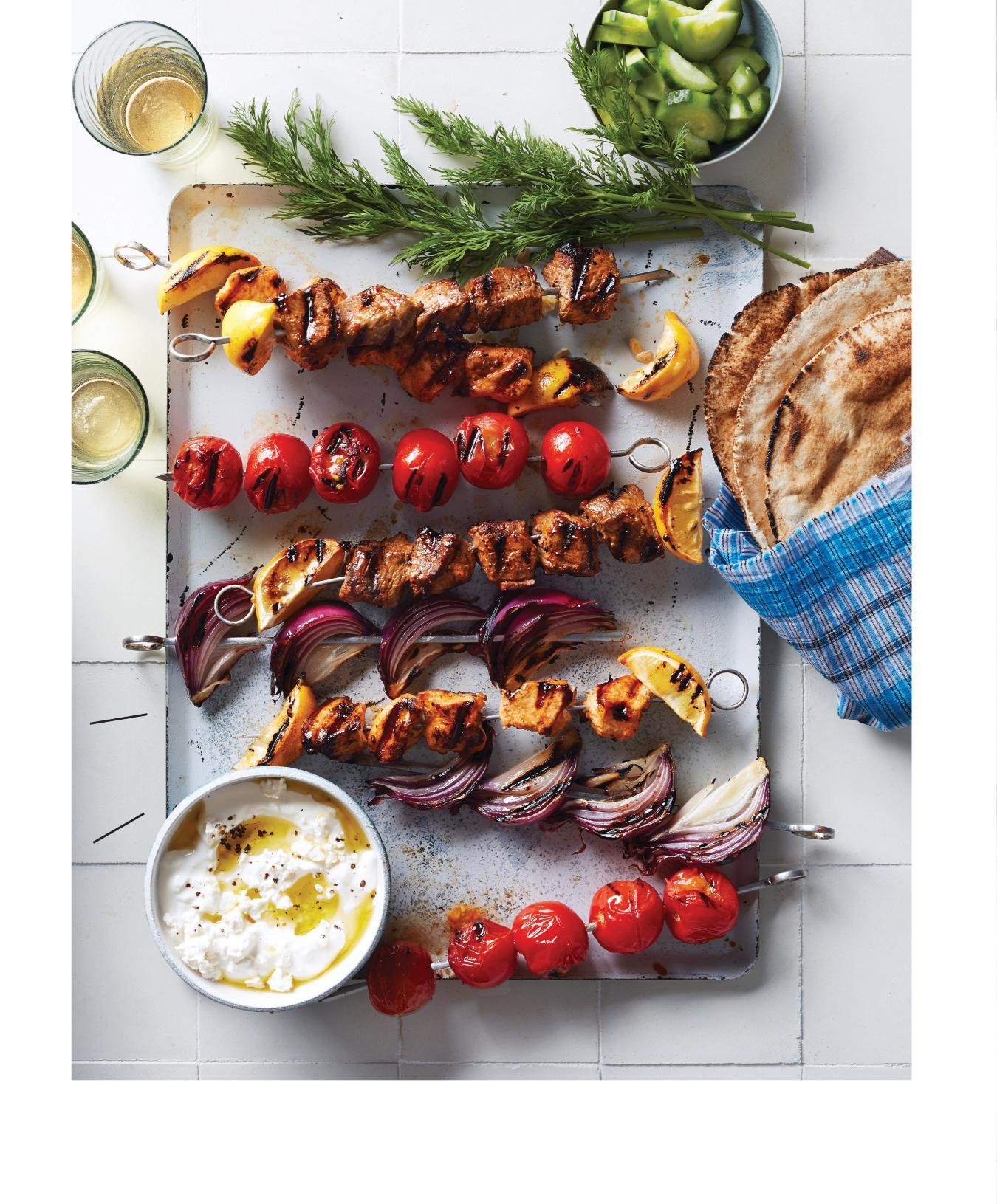
SUMMER SOUVLAKI
The best Greek food relies on fresh ingredients and simple techniques. Here, even the lemons and pitas hit the grill to get a little char, along with marinated lamb and chicken, cocktail tomatoes, and onion wedges. To make a superior souvlaki sandwich, slide the bites off the skewers into a soft, warm pita, and add a dollop of a feta-and-yogurt sauce that’s more complex than the usual tzatziki.
a good turn
Food can spin on round metal skewers during flipping and end up same-side down on the grill. The solution: Use flat or twisted ones to hold chunks firmly.
LemongrassSkewered Shrimp in Lettuce Cups
SAIGON SPIN
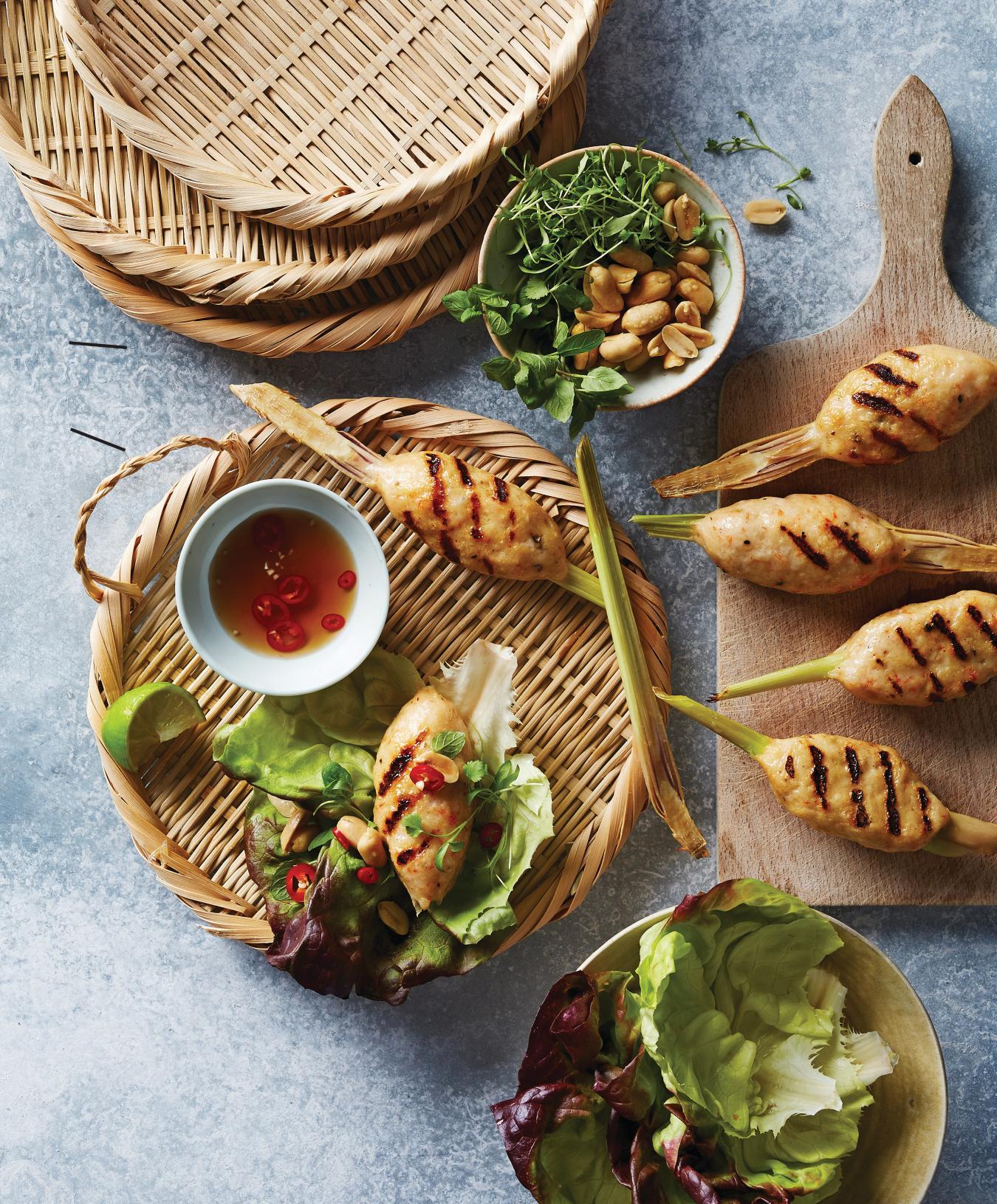
The popular Vietnamese party food called chao tôm—garlicky-sweet shrimp paste molded around pieces of sugarcane, then grilled—makes a light main course for a warm evening. We call for lemongrass stalks in this version; they’re easier to find than sugarcane and add a refreshing citrusy note.
painless prep
The shrimp mixture needs to be shaped and steamed before hitting the grill—a step you can take up to two days ahead. Make the dipping sauce that early, too, and kick back on the day of.
twice as nice
Use parallel skewers to keep larger pieces, like these skirtsteak portions, flat and easy to flip on the grill.
ISLAND SPICE
There’s your typical grilled sirloin, and then there’s churrasco. In much of Latin America, the term refers to any kind of skewered meat, but in Puerto Rico only flavorful skirt steak is used. Let it stand for 10 minutes after prepping and the seasonings will sear into a tasty crust as it grills. Our take on a sweet- and hotpepper sauce called ajilimójili (a-khee-lee-MO-khee-lee) lends a Caribbean piquancy.
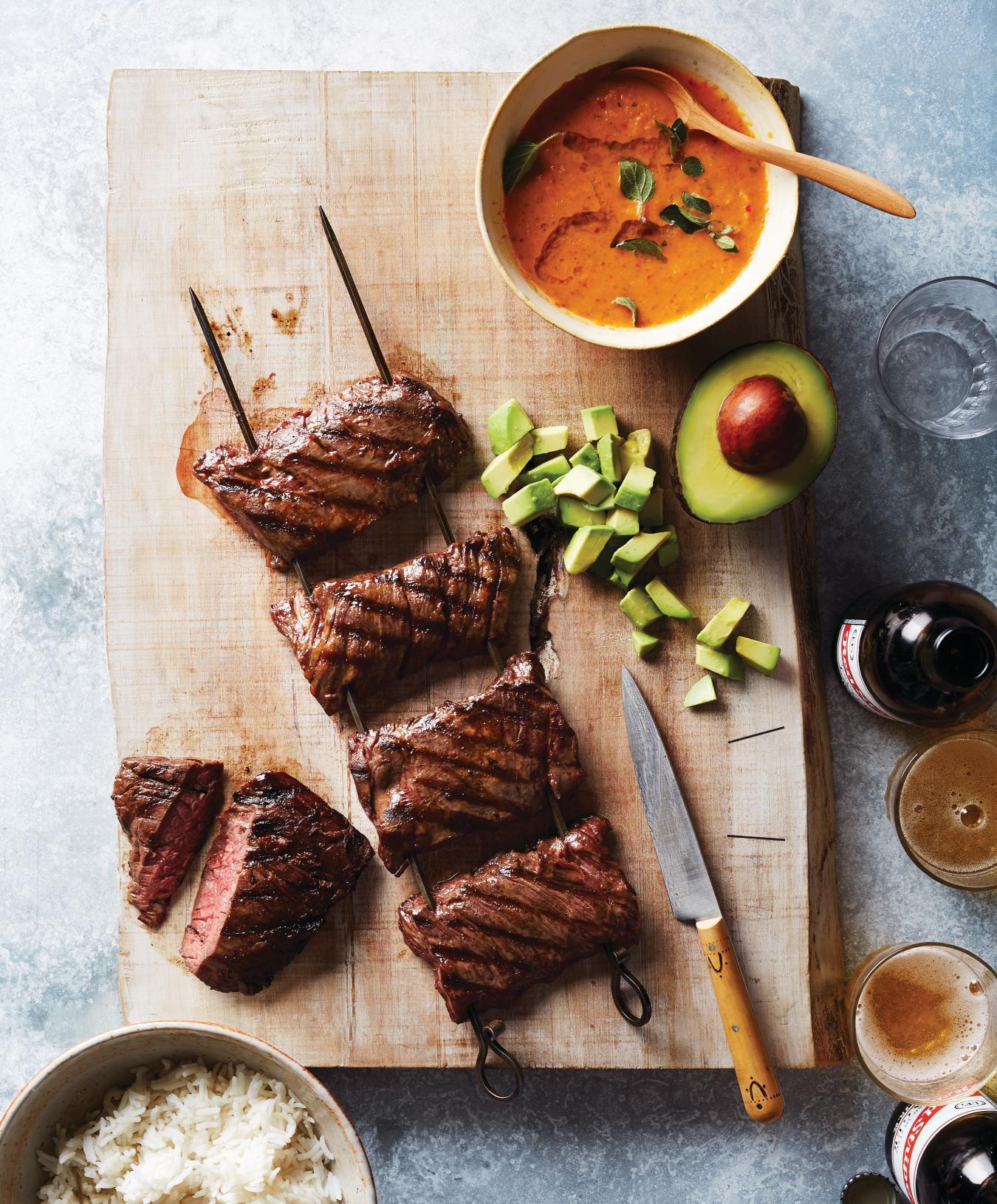
Skirt-Steak Skewers With Avocado and Pepper Sauce
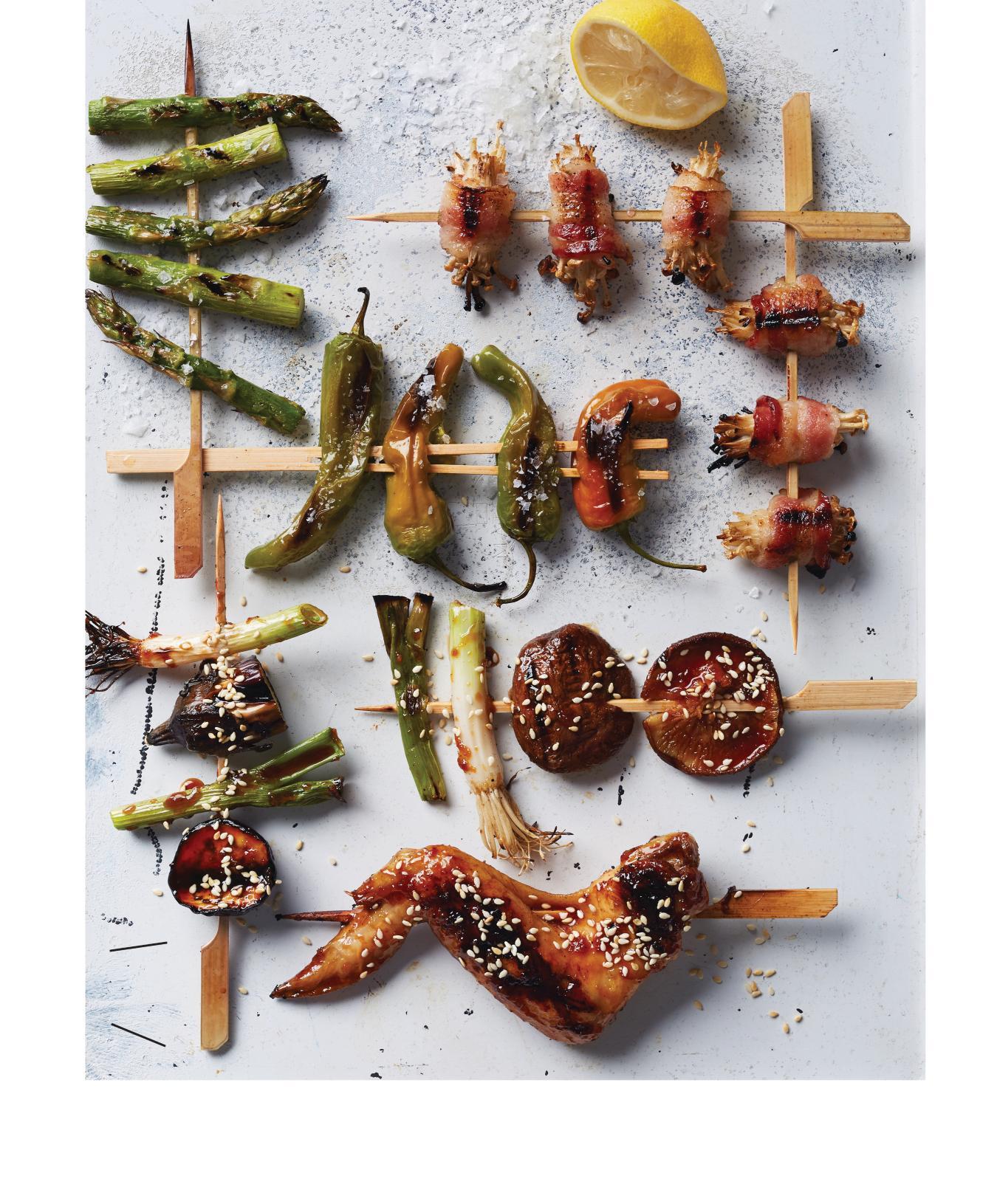
Teriyaki Chicken-Wing and Vegetable Skewers
TERIYAKI WITH A TWIST
In Japan, where there’s smoke, there’s kushiyaki—a term that describes a variety of grilled, skewered meats and vegetables. We give it two treatments here: chicken, eggplant, and shiitake mushrooms are basted with teriyaki, while shishito peppers, asparagus, and bacon-wrapped-enoki bundles are finished with a spritz of lemon juice and a sprinkle of sea salt to bring out the vegetables’ natural flavors.
For recipes, see page 109. stake a claim
Food clings well to both single- and double-pronged bamboo or wooden skewers, but they must be soaked in cool water for half an hour before grilling to avoid catching fire.
ranch style

PHOTOGRAPHS BY
Nicole LaMotte
TEXT BY
Catherine Hong
Blown away by its breathtaking location in the hills of Los Angeles, a couple looked past a dated 1940s single-story ranch’s exterior and imagined their dream home. Nearly 10 years and two kids later, they turned small rooms and a cramped configuration into an airy open-plan space with an easy indooroutdoor flow, a backyard begging for lounging and Nerf-gun wars, and stunning vistas for days.
“We wanted the backyard to be casual yet elegant for entertaining,” says co-owner John Dolan. They replaced a tiny patio with an expansive one, and planted a surrounding garden filled with succulents and California natives.

We gravitate toward modernism that is warm and inviting, rather than austere. We also wanted the house to feel timeless, to transcend trends,” says Dolan.
Douglas-fir cabinetry and oak floors warm up the sleek kitchen. The 4-by-12-foot soapstonetopped island provides an excellent surface for pastry dough and houses Sarah Lambert’s “dream” cooktop: a Gaggenau induction stove, which she prizes for its thermal precision. A clever popout cupboard holds Lambert’s mixer. The light fixture is from Roll & Hill.

When Sarah Lambert and John Dolan
bought their home in Los Angeles in 2005, it was the unique setting that seduced them. Located on a ridgeline high in the hills of Studio City, California, the property has knockout views in two directions, stretching as far as the San Gabriel and Santa Monica Mountains. The 1947 ranch structure, however, was less inspiring. “It felt dated,” recalls Lambert, a pastry chef who once owned a bakery in Mill Valley and now gives private cooking lessons. Its façade featured faded stucco and wood paneling, and there was a curlicued wrought-iron railing on the front porch. The interior, she says, had a “closed-in feeling,” with a choppedup floor plan and limited access to the outdoors. Still, Lambert and her husband, a commercial director, saw potential.
Nearly a decade passed before the couple started the rebuild (time flew while they focused on work and raising their two sons, Magnus and Jasper, now 9 and 8), but they collected ideas along the way. Wish number one: a kitchen that would function as the heart of a main living area. The original was tiny, with a single oven and a cooktop hood installed at the height of Lambert’s chin (she’s five-foot-ten); she also had to keep her baking gear in the oven and her blender in the garage. Maximizing the backyard was priority number two. “We didn’t cook or eat outside often, because the grill was down by the pool, and every little thing required another trip,” Dolan says. In 2013, with architect Barbara Bestor and landscape designer Judy Kameon, the couple pulled the trigger on the renovation. “We opened everything up,” says Bestor, who introduced oversize windows and glass doors in front and back. Inside, she had a central fireplace removed and reconfigured the living-dining-kitchen area as one space; also, the pitch of the roof was raised by more than a foot. Kameon added two large patios and a lush garden.
Though its footprint increased only slightly, the four-bedroom home feels much more spacious now—especially when the glass doors in the back are open and the family can eat, play, and entertain in the open air. “This house is a joy to live in every day,” says Dolan. Cool ranch, accomplished.

1
the living is easy
2
1 | Magnus, left, Lambert, Jasper, and Dolan often gather around the fire pit after dinner for s’mores. The furniture both inside and outside—like the pieces shown here and the coffee table below, all by Plain Air—is low and modern, in keeping with the home’s midcentury aesthetic. 2 | The oversize daybed, custom-designed by Kameon, is wide enough for the entire family to pile on.
clean lines, cool palette

1
1 | In the master bedroom, a framed photograph shot by Dolan hangs over a 1950s dresser designed by Richard Thompson and a lamp inherited from Lambert’s grandmother. 2 | The couple’s bedding is by Coyuchi. 3 | Brass fixtures, subway tiles, and a blue-and-white cement Moroccantile floor add color and personality to the master bath.
2 3
We wanted a house that was modest in scale but customized to our needs, and we got it. The light and flow make it feel much bigger than it is,” says Lambert.
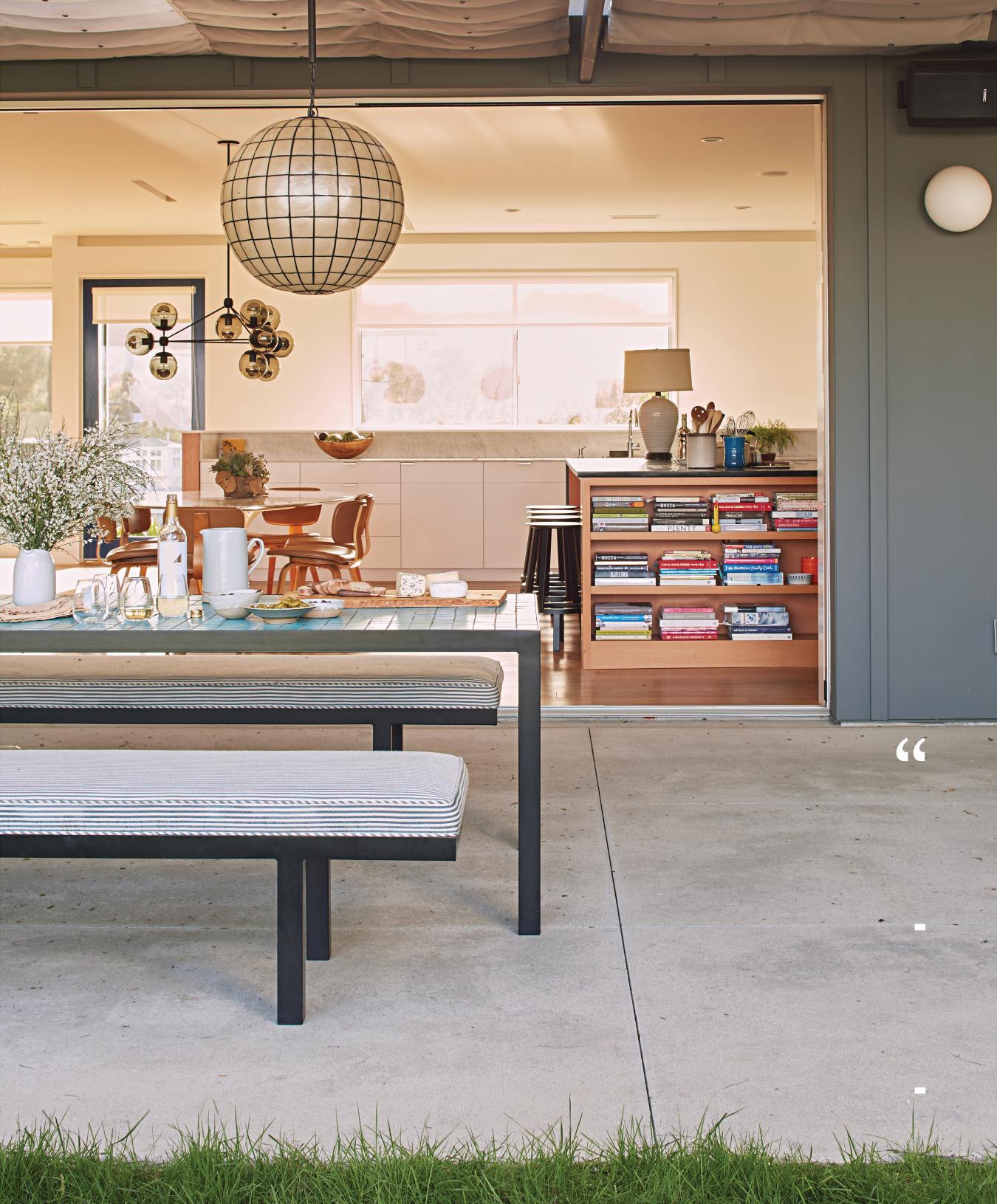
Capiz-shell globe lights from Restoration Hardware warm up the back patio, where a Plain Air dining table and benches are steps from the kitchen. Shelves built into the island display Lambert’s cookbooks.
IN
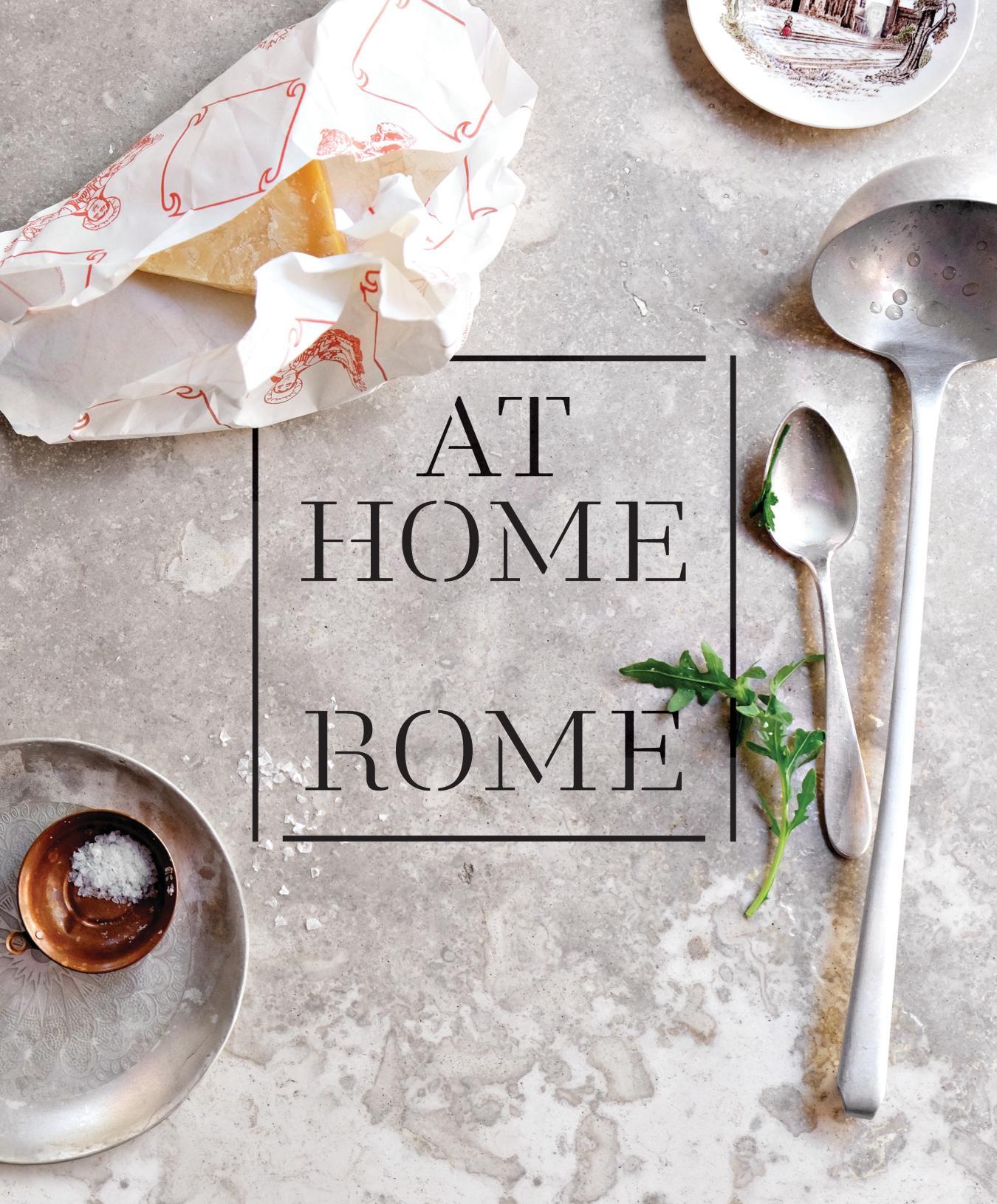
Whether you stay for a week or a year, a trip to a faraway place is a chance to get to know a culture from the inside—especially if you shop, cook, and eat like a local. When a New York City food writer and her family found themselves in Italy’s capital for seven months, they started out at the markets, and soon felt as if they’d lived there forever. Now back stateside, she shares how to find a feast for the soul, wherever you go.
PHOTOGRAPHS BY Simon Wheeler | TEXT AND RECIPES BY Anna Kovel
1 2
4 5
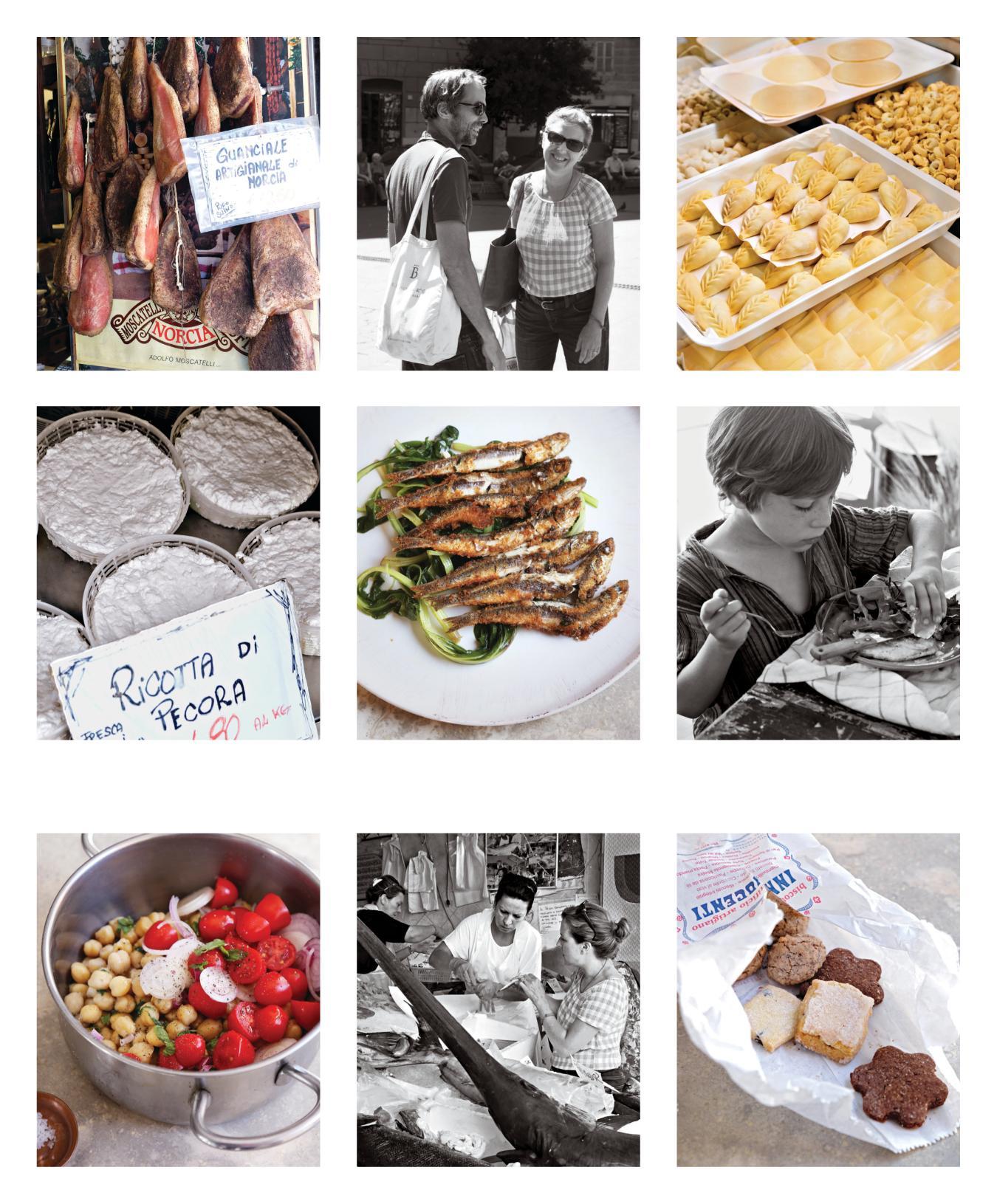
The small shops of Rome are full of regional delicacies. 1. Guanciale and other salumi at the butcher. 2. The author and her husband grocery-shopping. 3. Just-made pasta all’uovo. 4. Sheep’s-milk ricotta. 5. Fresh anchovies dipped in breadcrumbs and fried up. 6. The author’s son trying new tastes. 7. Presoaked chickpeas, quickly cooked at home, in a summer salad with tomatoes, onions, and herbs. 8. A lesson in cleaning fish at the pescheria. 9. Bakery-made sweets .
ere’s the thing about traveling: It’s so easy to just glide over the surface of a place—seeing a little bit of this, tasting some of that—while barely making a ripple, like a flat stone skipping on a river. But there is a different way, one that involves becoming attuned to the language, both spoken and visual, and to the seasons. The richest language, I have found, is that of food. You learn it at the markets, through the local produce vendors and the fishmongers. By visiting them daily and joining in the routines of a neighborhood, you can feel like a local—even if only for a few days.
That’s how my family lived when we ended up in Rome for the better part of a year. My husband had been offered the ideal position: teaching in a study-abroad program. We didn’t hesitate a moment before pulling our son out of first grade in Brooklyn and signing him up for school in a foreign city. Despite our lack of language skills or much of an itinerary, it was an opportunity for all of us to share an adventure—the kind that doesn’t come along often. There was no answer but yes. Among the three of us, we packed nine bulky bags, which we hauled off to the airport on a gray December evening. And between our first day and our last we found our way, step by step, along the worn black paving stones of a crowded Roman neighborhood—home.
We started slowly, listening to the winter rain pummel our little patio, situated in the ancient quarter of Trastevere, for weeks on end before giving way to the sweetly scented air of spring. Jasmine and bougainvillea exploded everywhere, and suddenly market tables overflowed with the first vivid Sicilian cherries; tiny, sweet strawberries; and blushing apricots with fragrant, soft skin. Exuberance was everywhere, and it was contagious: I wanted in. I wanted to know where those berries were grown, how many more weeks until the fava beans would appear, and how best to cook the fresh anchovies I saw at the pescheria. I didn’t yet have the Italian words to ask about any of this, so I watched and learned.
All of this curiosity and longing wasn’t just about putting dinner on the table; food is my passion and my work. I am a professional cook and food stylist, and a former food editor at Martha Stewart Living. So most days I would experiment with the fresh things I bought by putting together meals in the kitchen of our home. We saved restaurants for visits from friends and weekend lunches, when we’d linger, Italian-style, over plates of pasta all’Amatriciana and rabbit alla cacciatora. The other exception was Friday, when the family would stroll to the Neapolitan pizzeria Ai Marmi and watch the taciturn pizzaioli spin their dough and stoke the fire. Afterward, my son would choose a creamy dessert in a tall conical glass to end the school week decadently with the dip of a long spoon.
Between meals—and not least because of our enjoyment of them—we began to pick up a bit of basic Italian, and also an inkling of what creates the layers of a community and its customs. Our experience of setting up a home, shopping at markets, and sharing our favorite places with visiting friends created a love for Rome that feels eternal. We developed a crush, like the juice of the red blood oranges at our corner bar, on the city: on its edges, as sharp as the bitter greens on our table and as salty as pecorino Romano; yet also on its gentle sweetness, like that of the ripest fig. If only that sentiment could have defined the first of many chapters. Instead it was a long introduction that offered warm and valuable lessons for making yourself at home, wherever you may roam.

1
MORNINGS ARE FOR MARKETS
Wander the stalls early, while the cobblestones are still cool, and watch for what’s new each week. Stone fruits from Sicily, like the dark cherries (ciliegie) and delicate doughnut peaches (pesca tabacchiera), below, appear in early summer. They are best consumed within days of harvesting, so let your vendor choose for ripeness based on when you plan to eat the fruit—today (oggi) or tomorrow (domani).
2
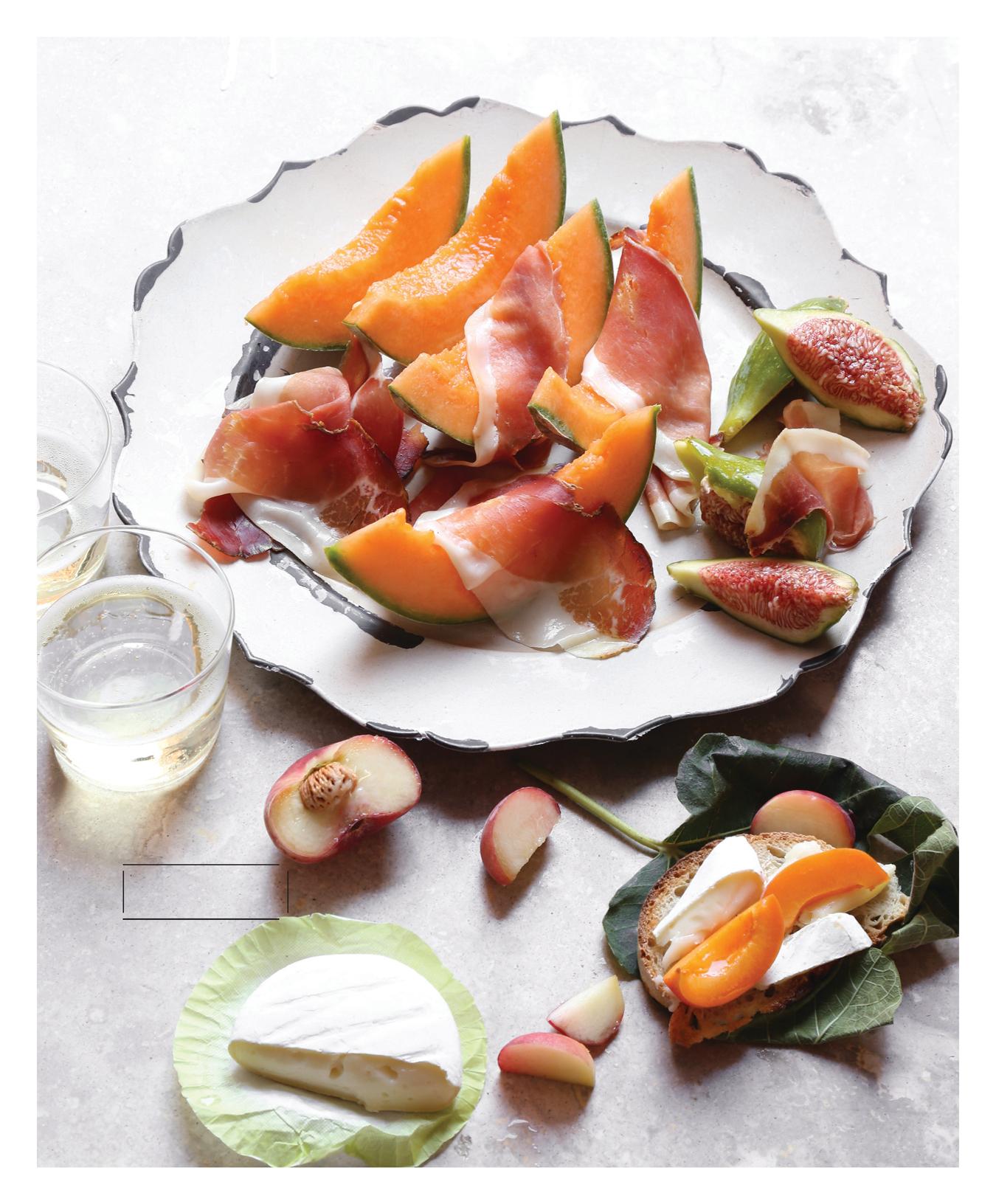
START WITH THE CLASSICS
And then build on them. Ripe melon and prosciutto di Parma make a perfect couple, but other ingredients pair well, too. Speck, a cured ham from the Dolomite Mountains, brings a smoky note; fresh figs, doughnut peaches, and mellow June apricots are sweet additions; and a creamy cheese (such as Robiola) adds depth.
TALK TO THE EXPERTS
Once you learn a few basic words, you’ll feel more comfortable at the alimentari and the butcher counter. If you don’t know how much you need, for instance, tell the shopkeeper how many you’re serving (for four people: “per quattro persone”), and she will do the math. Or ask, “Posso?” (“May I?”) while gesturing at a basket of produce, and the vendor will hand you a plastic bucket to fill yourself.
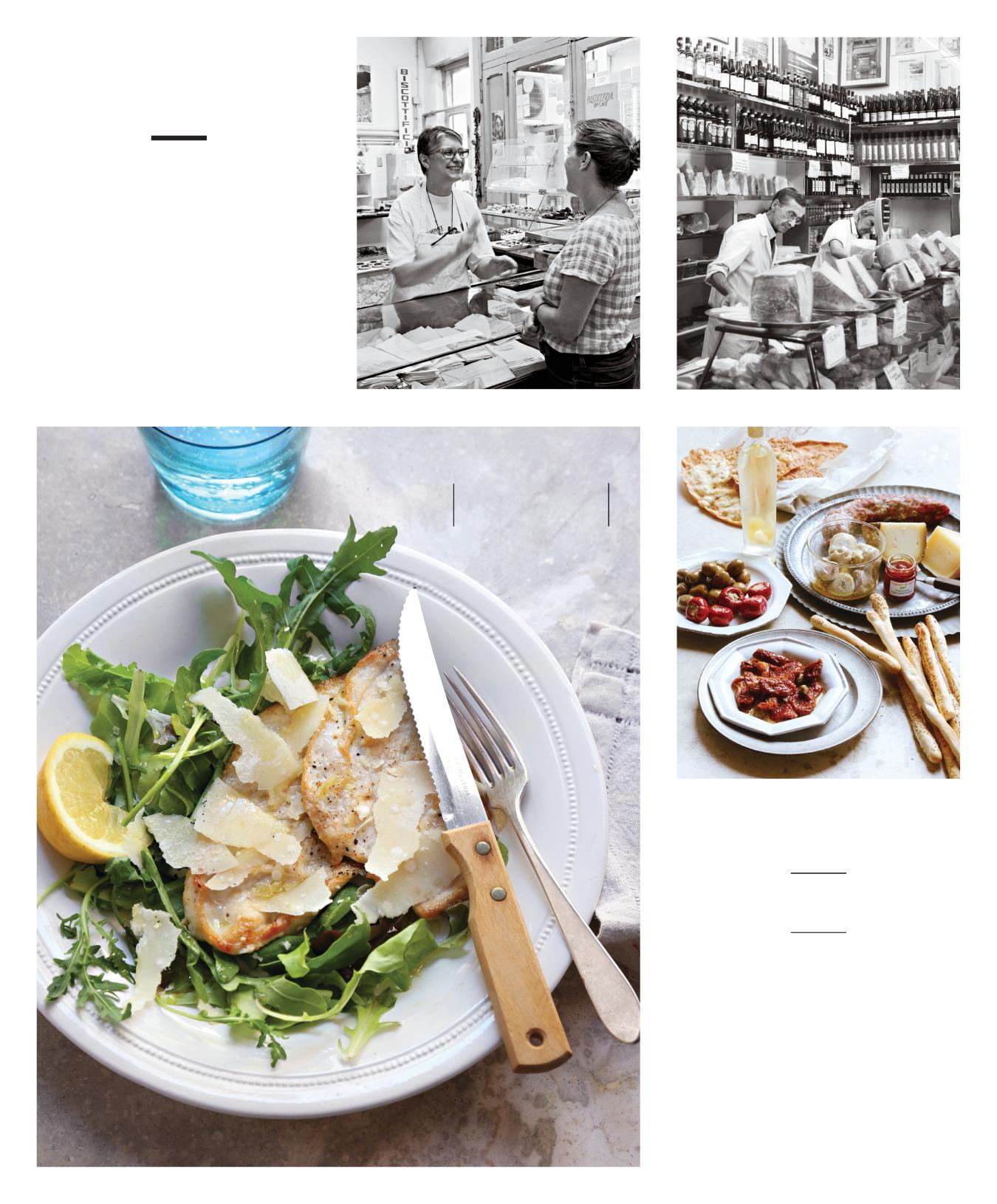
4
DARE TO BE SIMPLE
With ingredients this fresh, you don’t need to fuss. Have the butcher slice and pound your chicken; then you can pan-fry and serve it with greens, a few shavings of cheese, and a squeeze of lemon. This truly is dinner in 10.
5
KICK BACK AT DUSK
The aperitivo hour is a tradition worth honoring. Get store-bought marinated peppers, olives, and tomatoes and enjoy them with local salumi, cheeses, artisanal flatbreads, and handrolled breadsticks that speak to regional styles and culture. Then take time out to sit and talk, looking at the golden light with a spritz in hand.
6
COOK STEMTO-BLOSSOM
Italians leave no part of the vegetable behind—easy enough to do when you have an abundance of fiori di zucchine (zucchini flowers). Use the petals to top ricotta-filled cannelloni, and cook the zucchini into a savory side.
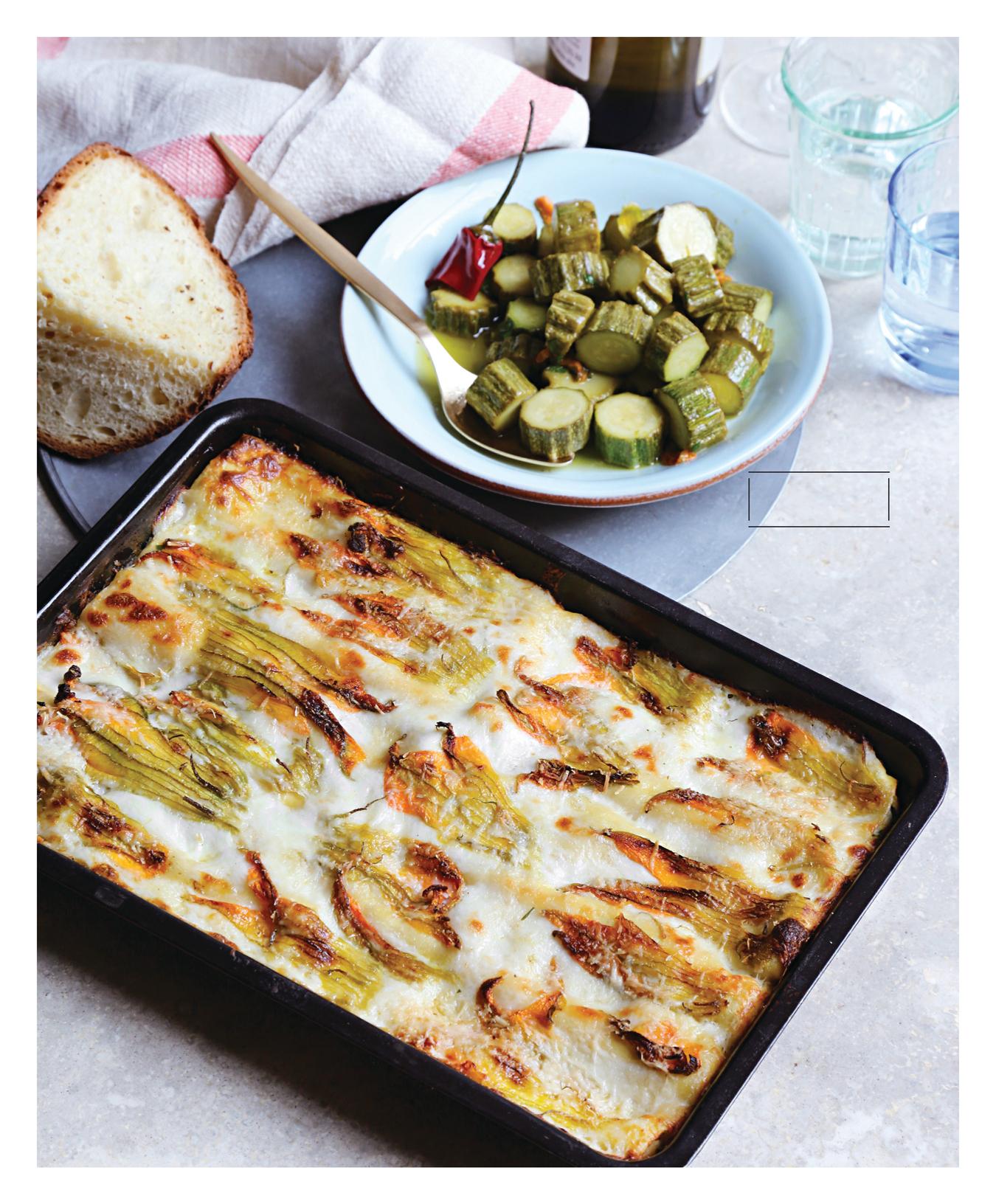
7
ASK FOR DIRECTIONS
This recipe for delicate spinach gnocchi with clams—a Sardinian favorite—is courtesy of the pastaio (pasta maker). Don’t hesitate to reach out for guidance, even if you have to use lots of hand gestures; the grumpiest of shopkeepers will respond to genuine curiosity and a smile.

9
LET SOMEONE ELSE COOK
Romans take shortcuts (when they’re delicious), so why shouldn’t you? Roasted meats and cooked vegetables, such as these stuff ed tomatoes, below, are readily available. After you’ve been out seeing the city, bring something home to anchor a summer dinner with bread and wine.
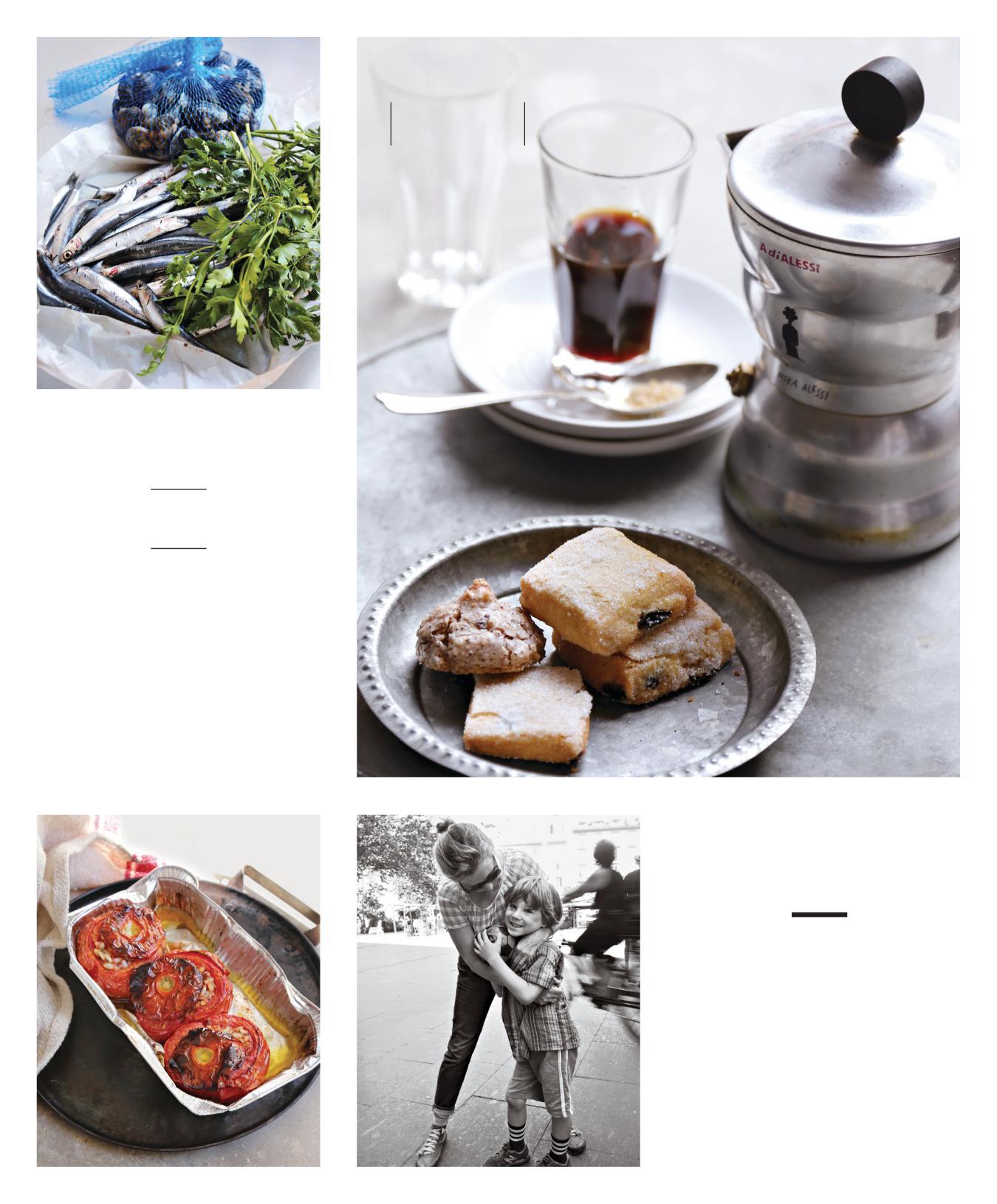
TAKE THE HINT
Just-caught seafood, like anchovies and clams, left, is often sold with a handful of parsley— a gentle suggestion that the two belong together, much like espresso and dolci, below.
10
ENJOY THE MOMENTS
The best lesson is simply this: Slow down. I learned to prolong the warm evening hours, watching children kick a soccer ball, or sitting on fountain steps as a zany clown performed in the piazza. Adjust your schedule, share stories of the day with your loved ones while dinner waits, and bring home the ripest berries from a stall or sweetest cookies from your favorite bakery— it’s the local way.
WHAT CAN I BRING?
If the answer is dessert and the event is a cookout or pool party, make a splash with a classic crowdpleaser. We’ve updated six oldies but goodies, from a mouthwatering fruit crumble to banana pudding to s’mores.
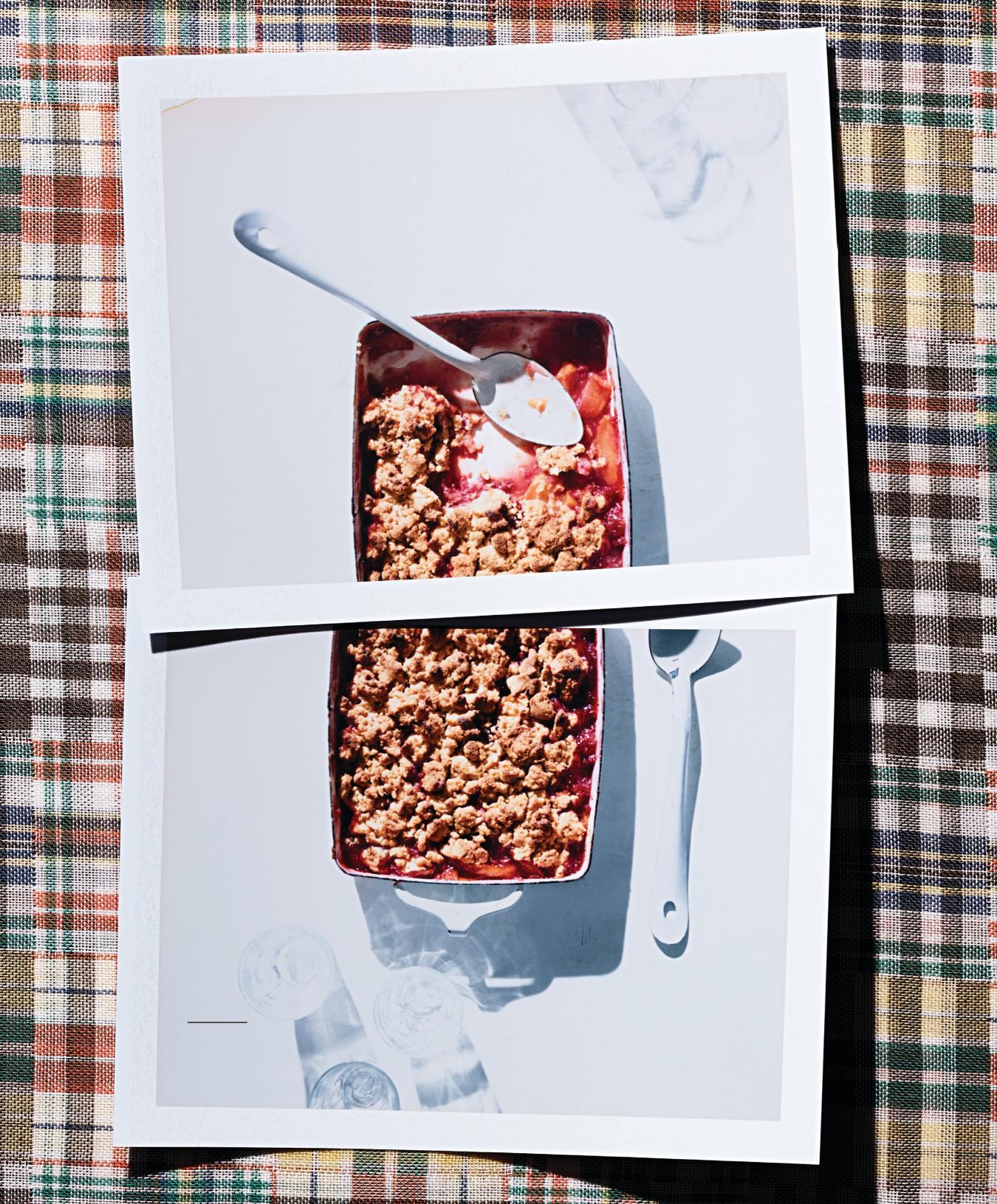
PHOTOGRAPHS BY JOHNNY MILLER
NECTARINERASPBERRY CORNMEAL CRISP
The first step in this beloved recipe is to hit the farm stand. Bursting with fresh nectarines and raspberries, our version has a cornmeal topping in lieu of the usual oats for an extra-satisfying crunch.
TOASTED S’MORES PIE
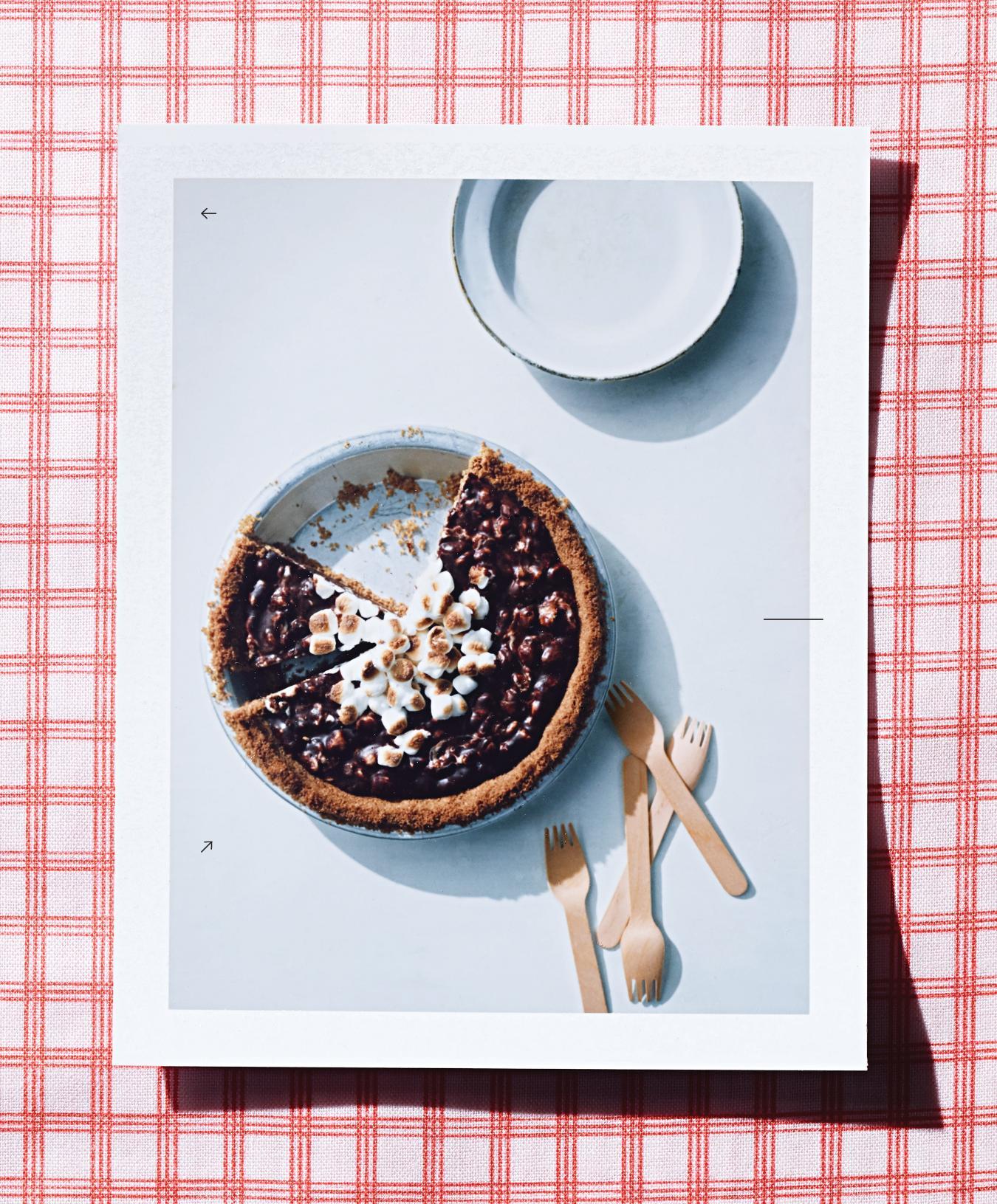
Everyone loves roasting marshmallows over a flame, but it can get complicated at a big party. Instead, capture the spirit of a camping trip with this pie, made decadent with a graham-cracker crust, a rich chocolate-ganache filling, and toasted marshmallows and flaky sea salt on top. For recipes, see page 112.
GIVE YOUR INNER SCOUT A BADGE FOR THIS ONE.
DIG IN! THIS HEAPING BOWL SERVES A DOZEN.
STRAWBERRY-BANANA PUDDING

Don’t worry—we wouldn’t dare touch the Nilla Wafers in this iconic southern treat. They’re layered right in there along with sliced bananas, homemade vanilla pudding, and fresh whipped cream. The one twist: sliced strawberries, which add a refreshing zing and a shot of color.
PREPARE TO ANSWER: MAY I PLEASE HAVE ANOTHER?
COWBOY COCONUT BARS

Think of them as chewier, gooier versions of the classic cowboy cookie, a salty-sweet confection loaded with chocolate chips, oats, pecans, and coconut flakes. They’re also perfect for potlucks, since one batch makes 16 bars that stack easily for transport.
VANILLA SHEET CAKE WITH LEMON CREAMCHEESE FROSTING

What makes this timeless buttermilk cake sparkle? The tangy, lemony frosting is sprinkled with lemon zest tossed in granulated sugar for a sweet, citrusy crunch. Cut it into squares and serve them with an optional tumble of fresh blueberries, and you’ll never go storebought again.
LOOKS DIVINE, TASTES DELICIOUS.

NEAPOLITAN CUPCAKES
Fighting over the chocolate stripe in the ice cream carton—it’s as vivid a childhood memory as running through sprinklers. Fast-forward to these cuties. Two layers of batter (from the same batch, with cocoa powder and chopped chocolate added to half) form rich stripes, and puréed strawberries brighten up the buttercream frosting.
YUMMY MOUTHFULS THAT SCREAM, “SCHOOL’S OUT!”
PARTNERS'
PICKS
Make something delicious on a Whim™ this month, and serve it up in blue-accented ceramic bakeware that’s perfect for going right from the oven to your tabletop.
1

4
1. Meat Temperatures & Kitchen
Conversions by Martha Stewart Wall Art Decals™, available at Fathead, $14.99, fathead.com/marthastewart.
2. Created with Fine Glitter and
Glittering Glue by Martha Stewart Crafts®, available at Jo-Ann Fabric and Craft stores, $4.99 – $9.99, joann.com. 3. File Folders by Office by Martha Stewart™, available exclusively at Staples, $5.99, staples.com/marthastewart. 4. Ceramic Bakeware from Whim™ by Martha Stewart Collection™, available exclusively at Macy's, $24.99 – $56.99, macys.com/martha. 5. Peyton Entertaining Island by Martha Stewart Living™, available exclusively at Home Decorators Collection; in Picket Fence, $999, homedecorators.com/marthastewart.
Office by Martha Stewart™, staples.com/marthastewart | Martha Stewart Wall Art Decals™, fathead.com/marthastewart | Martha Stewart Living™, available exclusively at Home Decorators Collection, homedecorators.com/marthastewart | Martha Stewart Collection™, available exclusively at Macy’s, 800-289-6229, macys.com/ martha | Martha Stewart Crafts®, Lion Brand® Yarn, 800-661-7551, marthastewart.lionbrand.com | Martha Stewart Crafts®, Paint, 800-842-4197, plaidonline.com/ marthastewartcrafts | Martha Stewart Crafts®, Paper Crafts, 800-794-5866, eksuccessbrands.com/marthastewartcrafts | Martha Stewart Living™, available exclusively at The Home Depot, 800-466-3337, homedepot.com/marthastewart | Martha Stewart Pets®, available exclusively at PetSmart, 888-839-9638, petsmart.com/ marthastewart | Martha Stewart Rugs™, Safavieh, 866-422-9070, safavieh.com/designers/marthastewart

